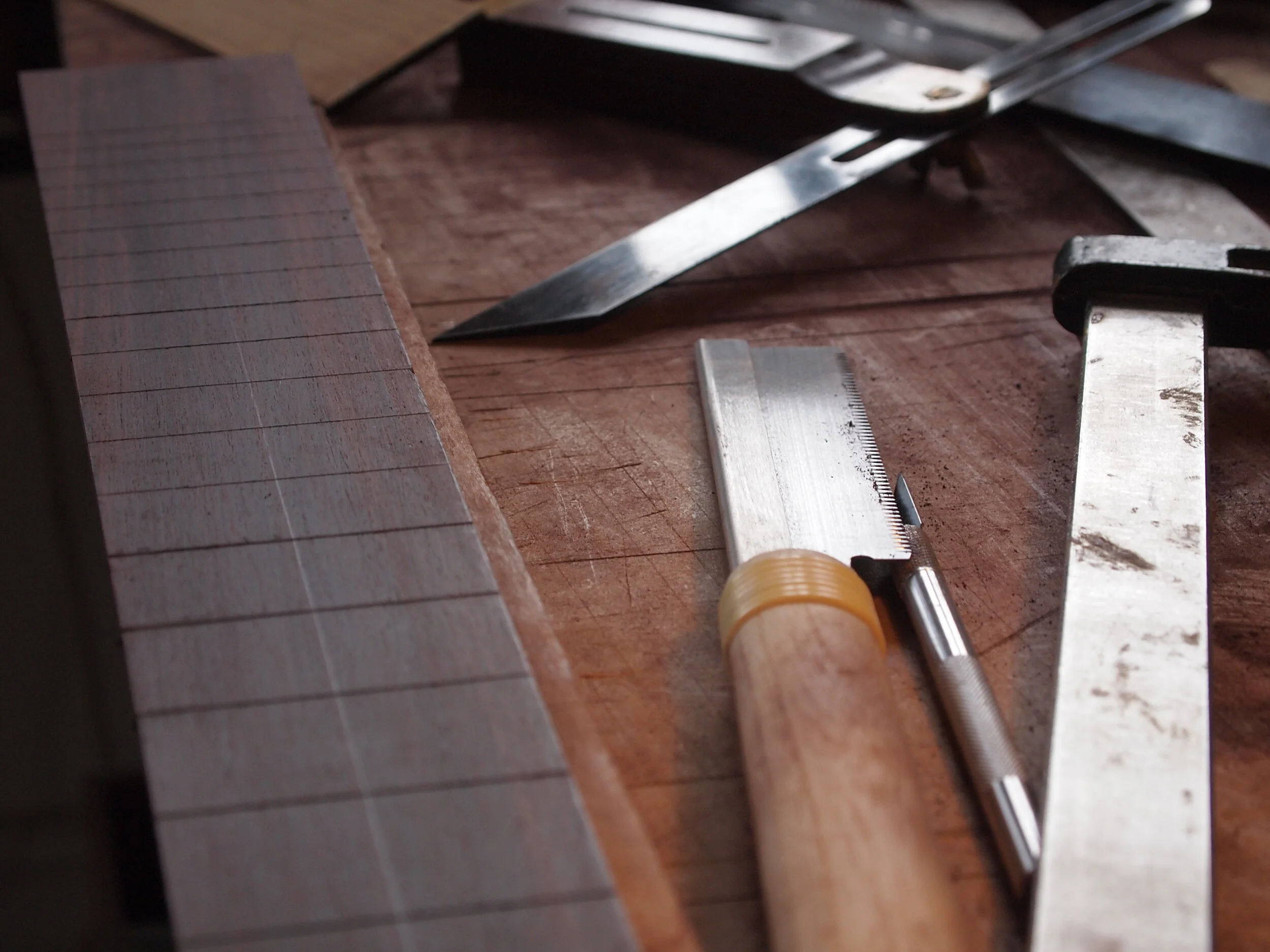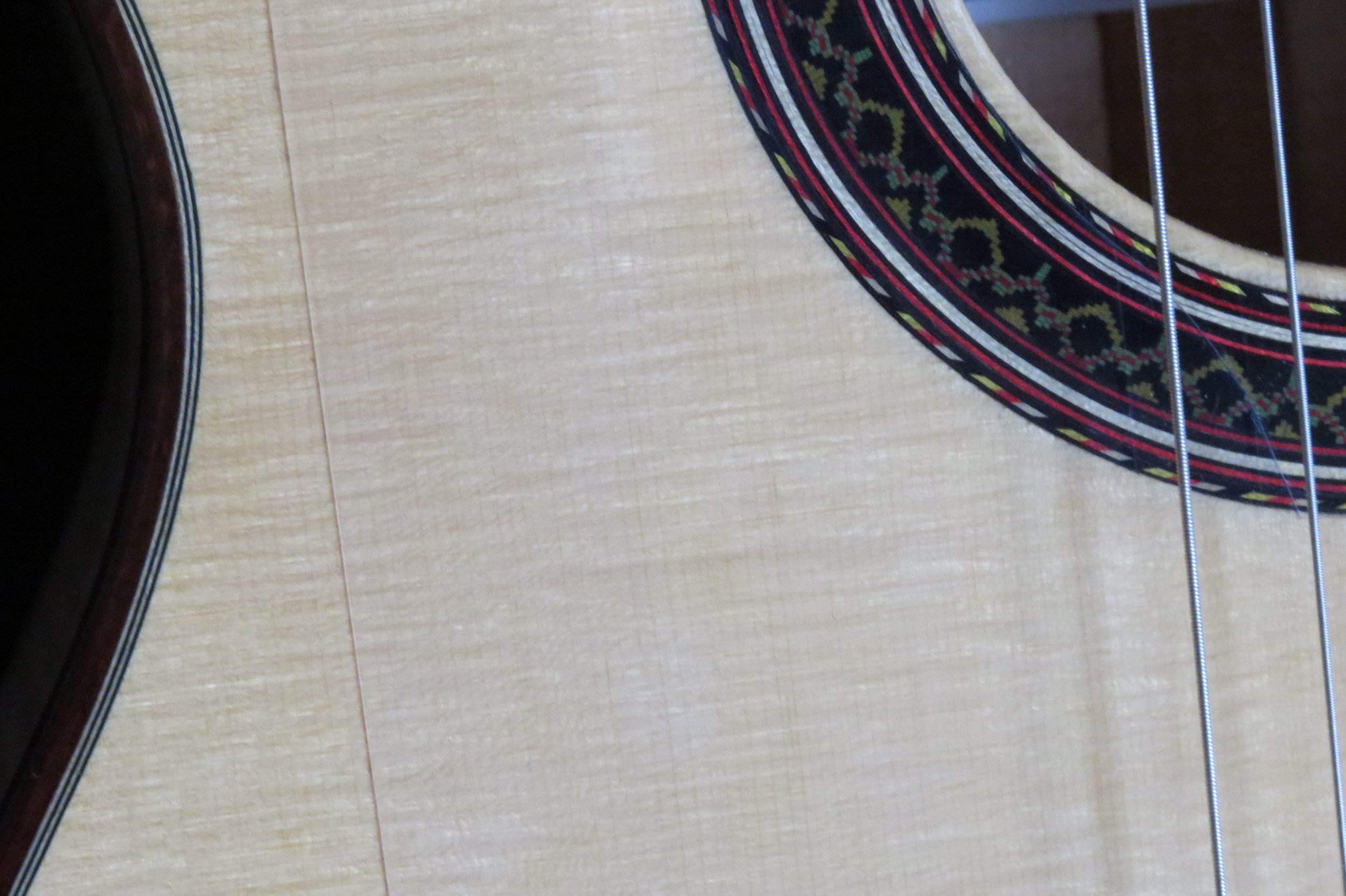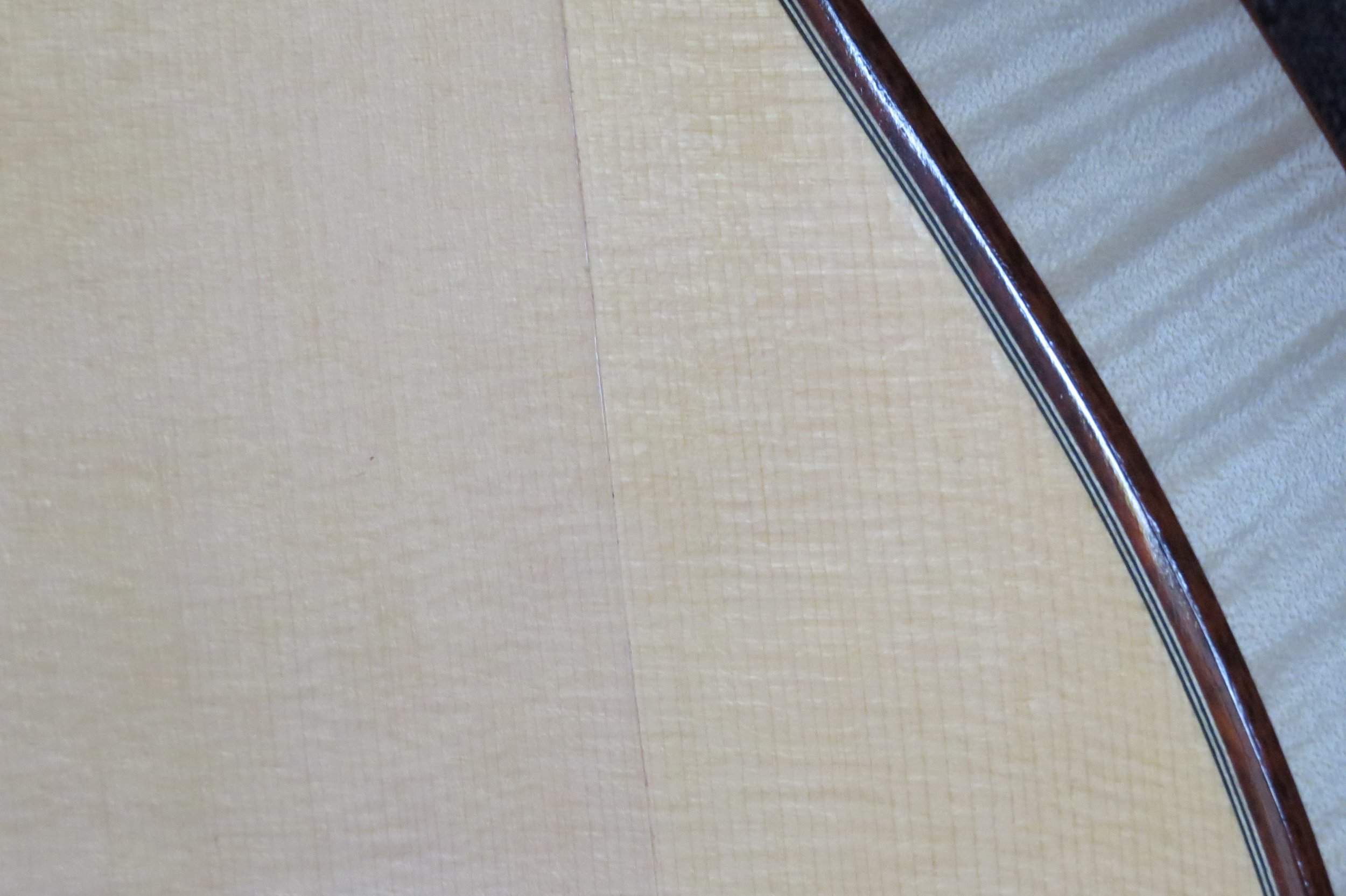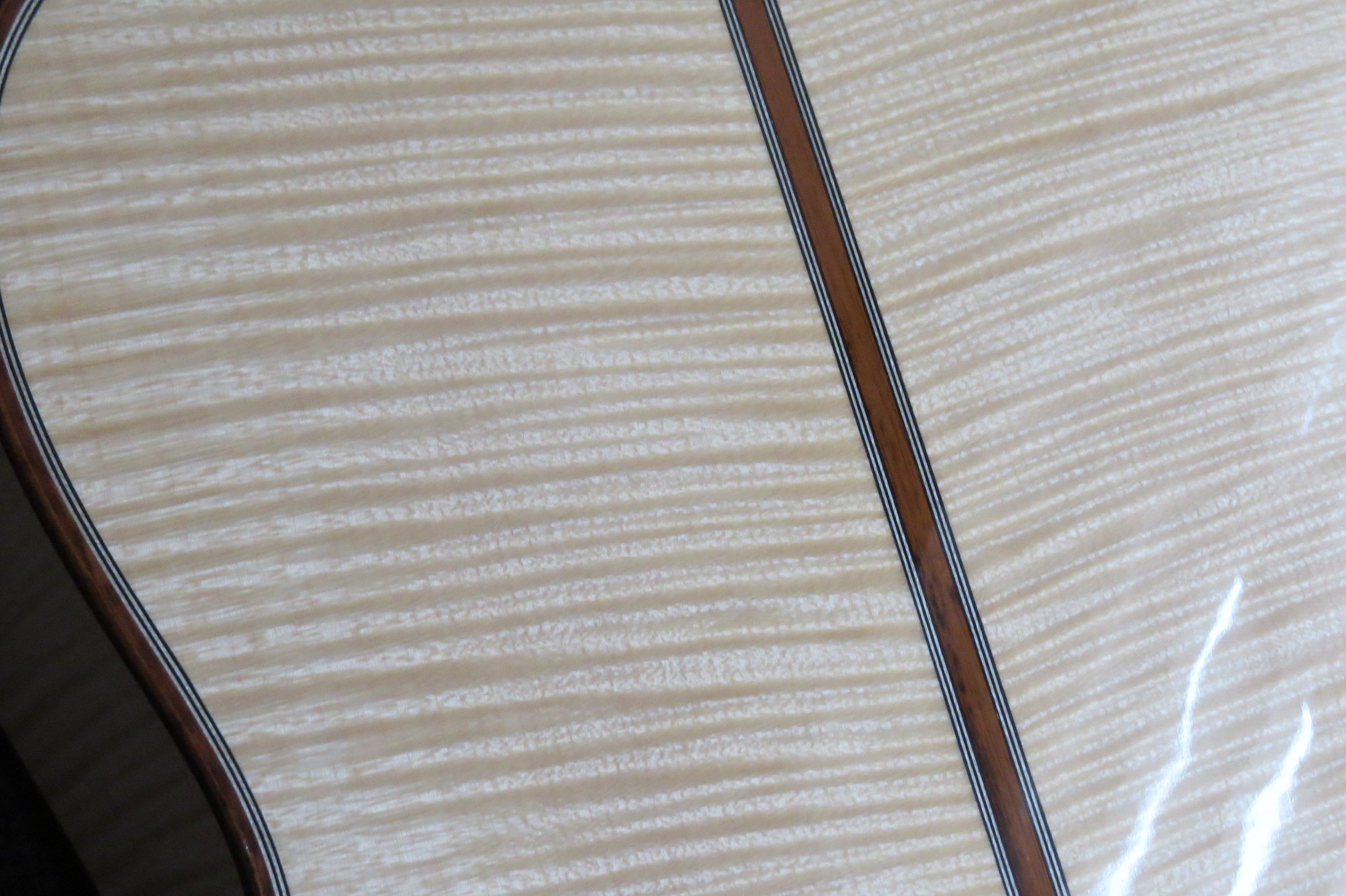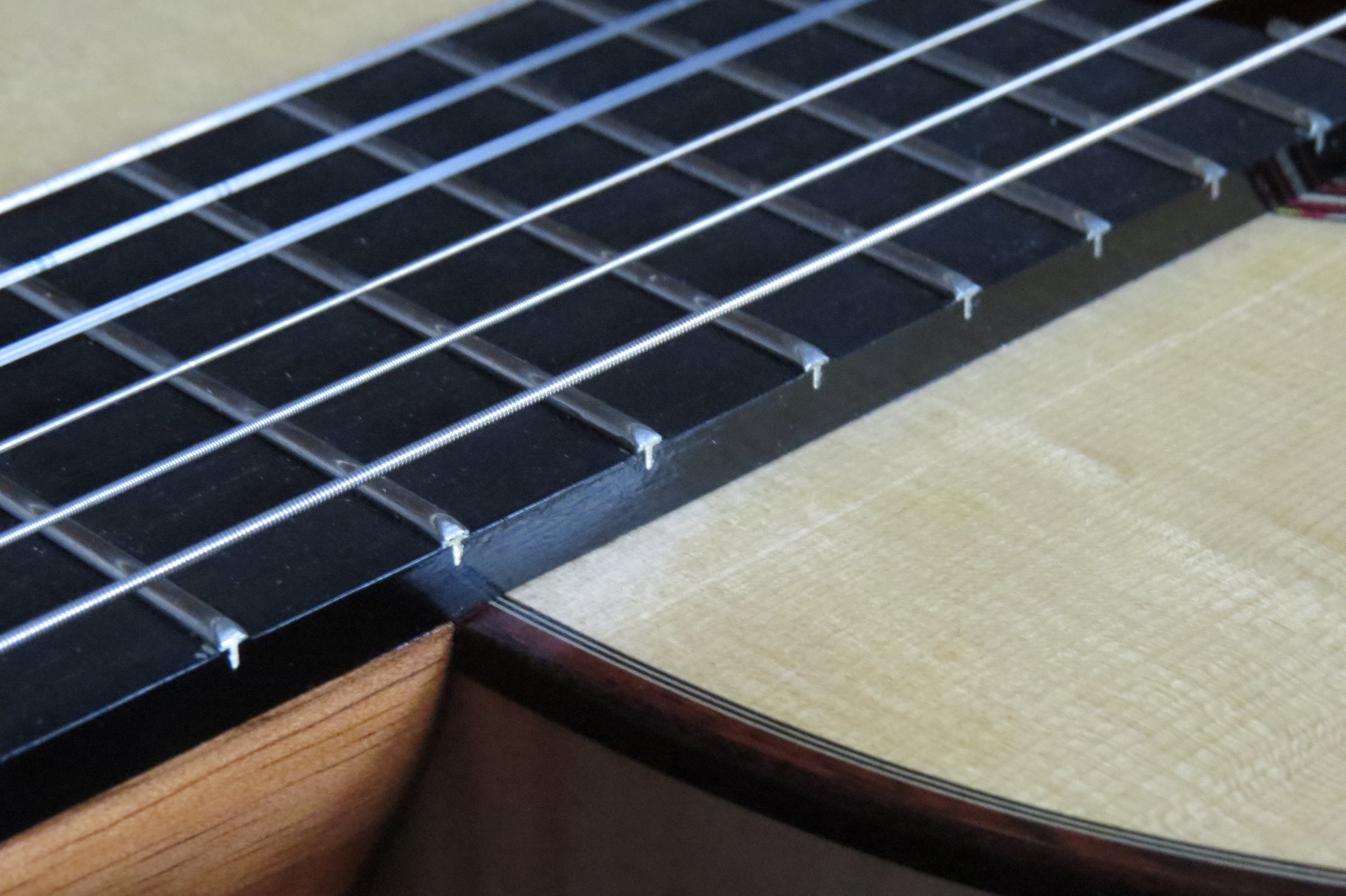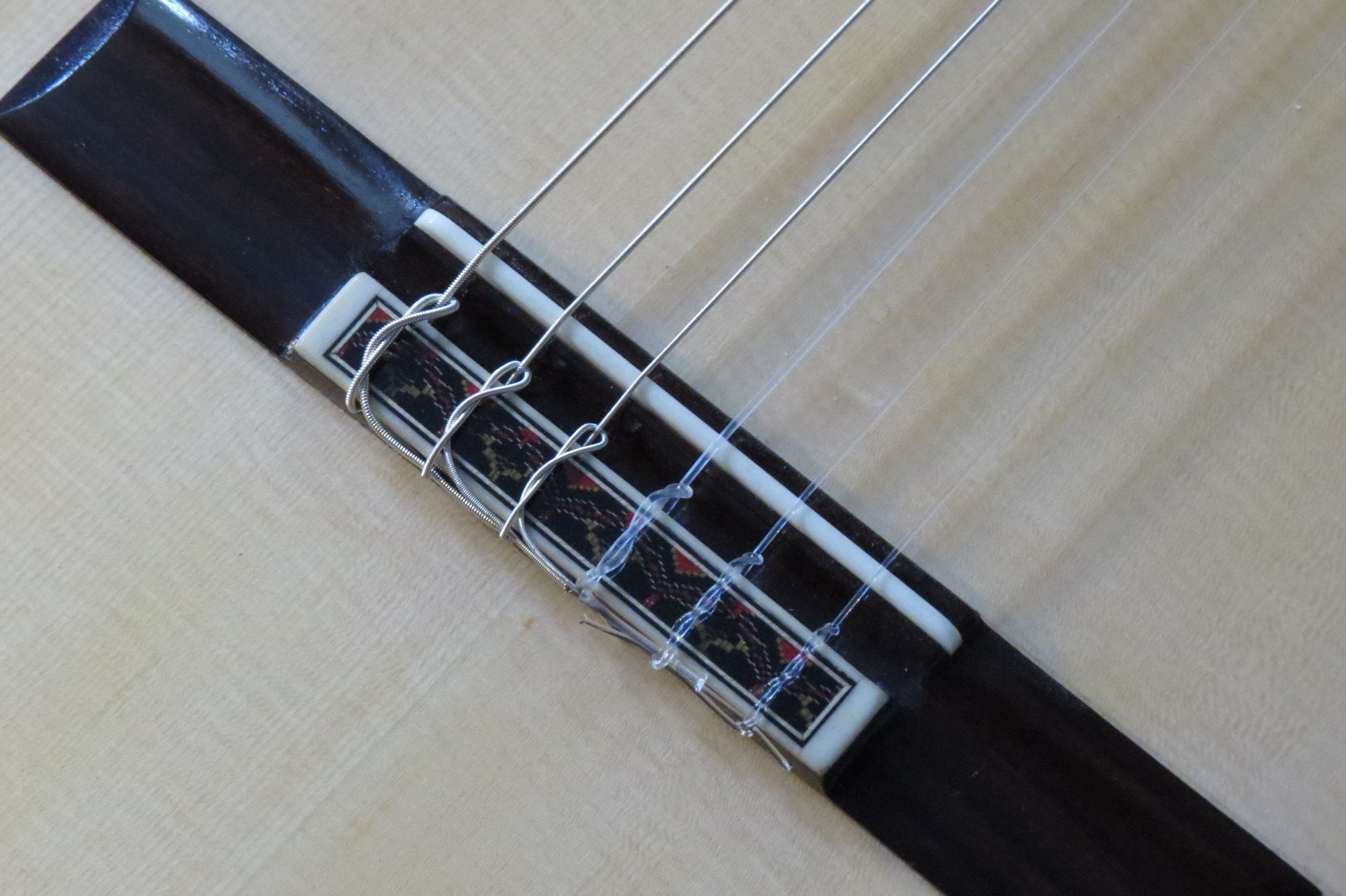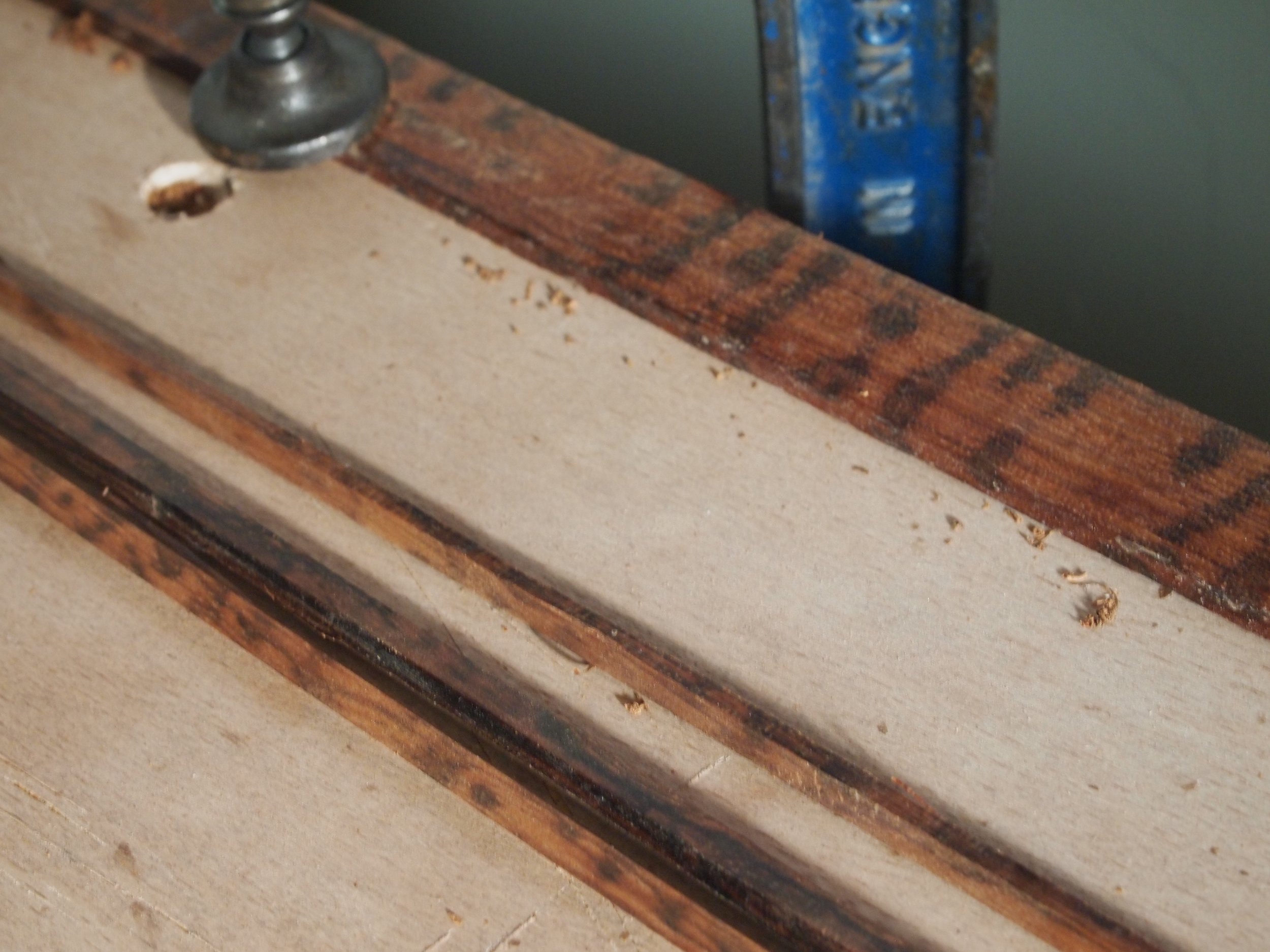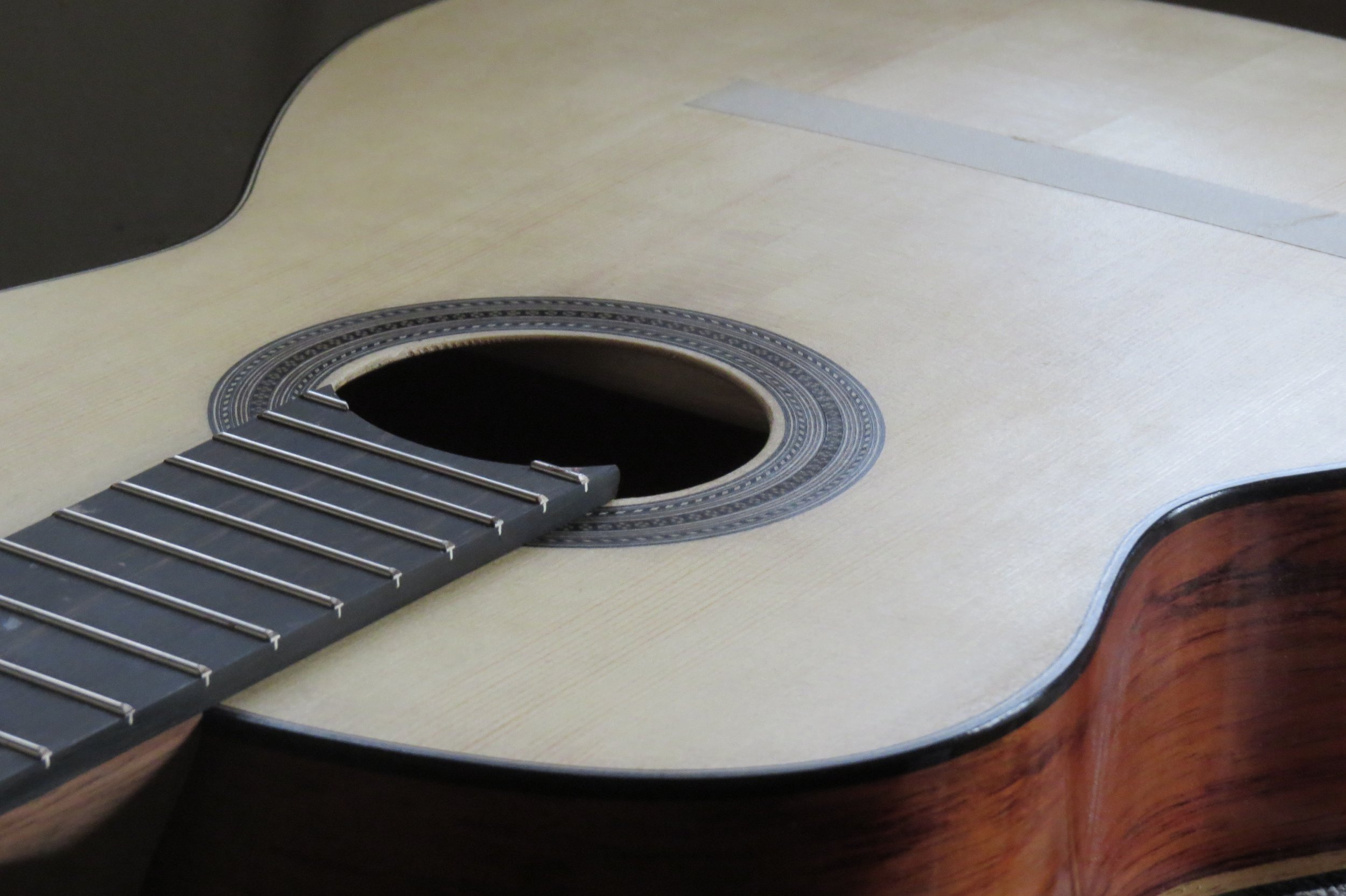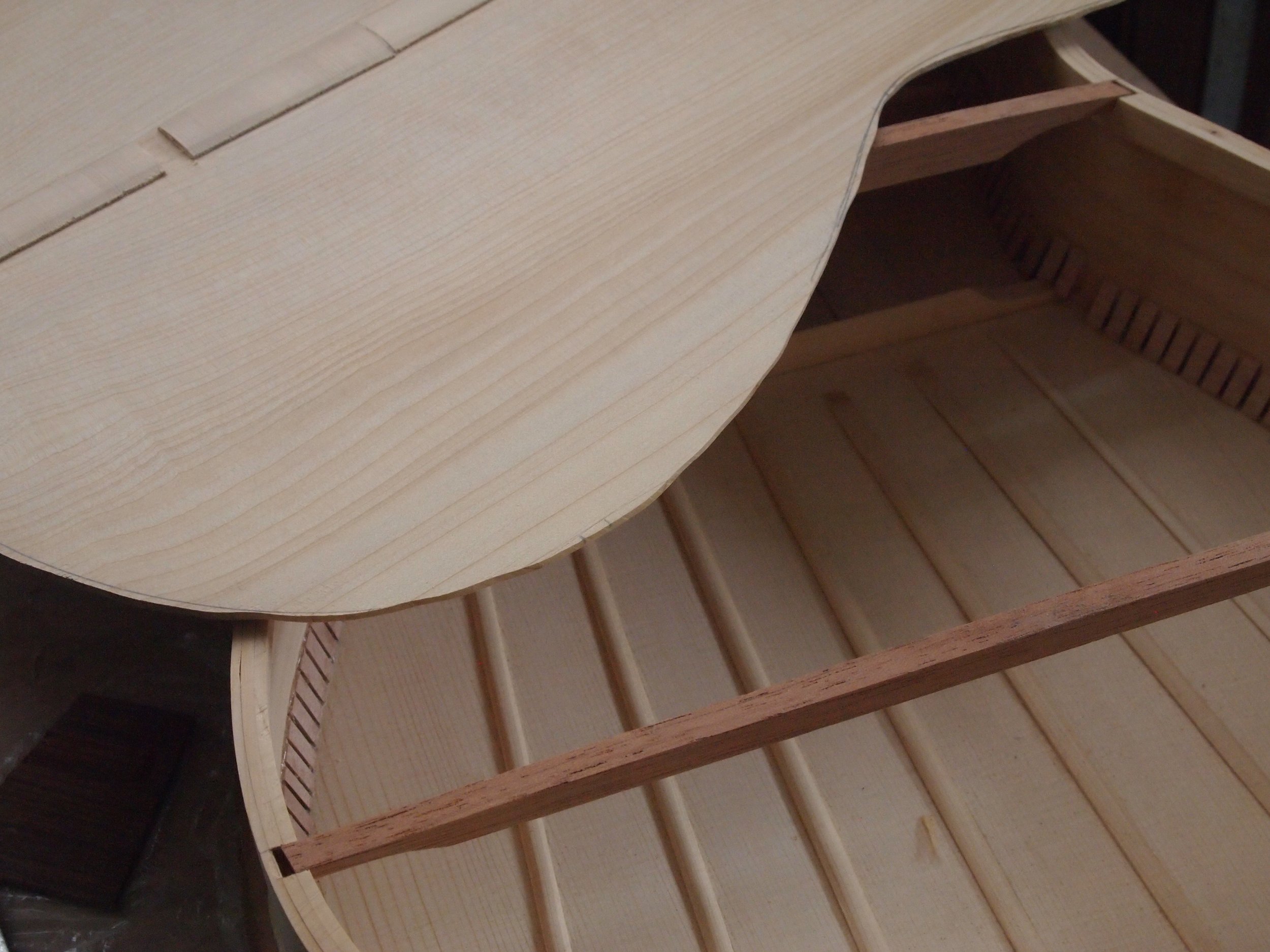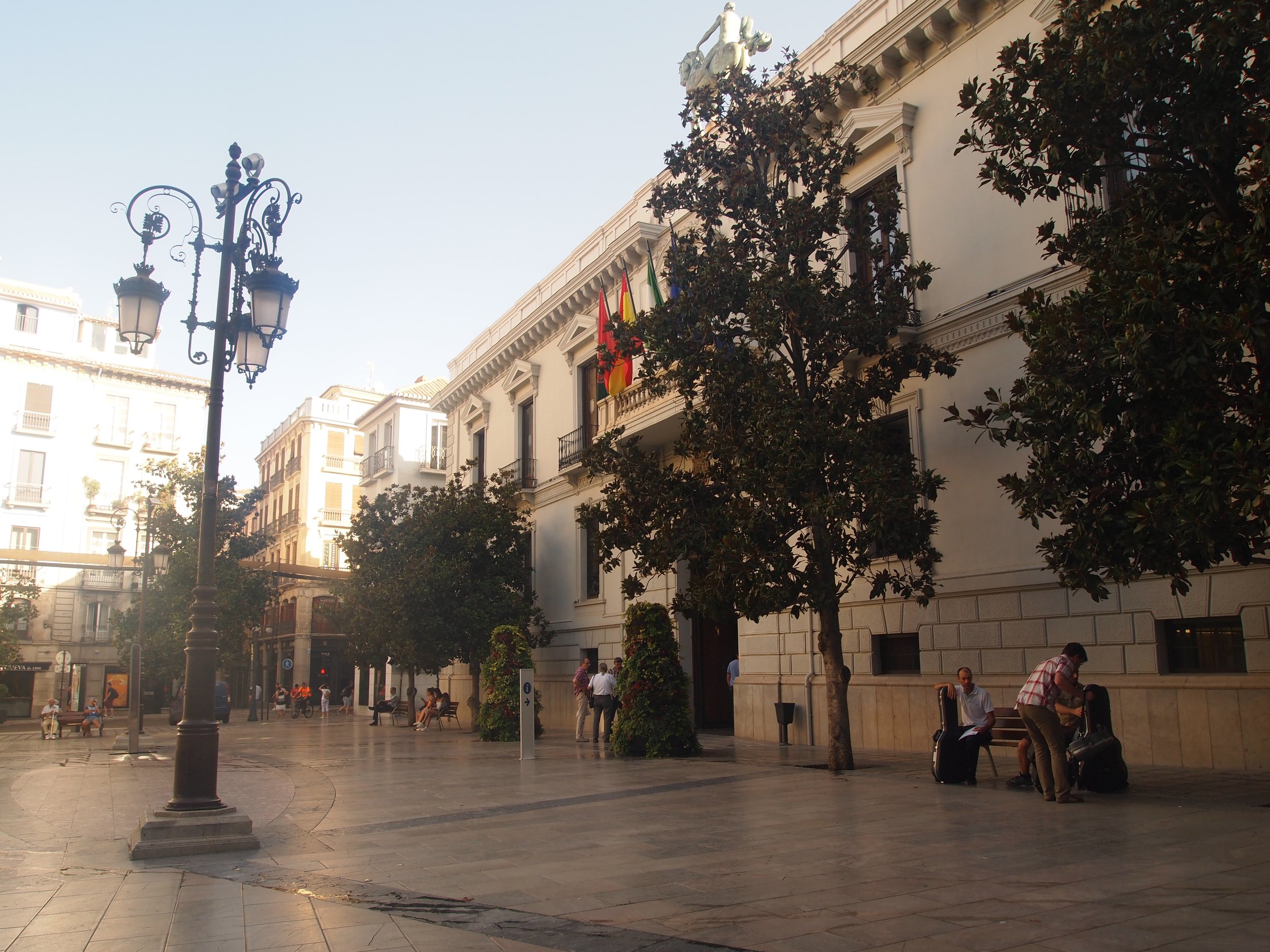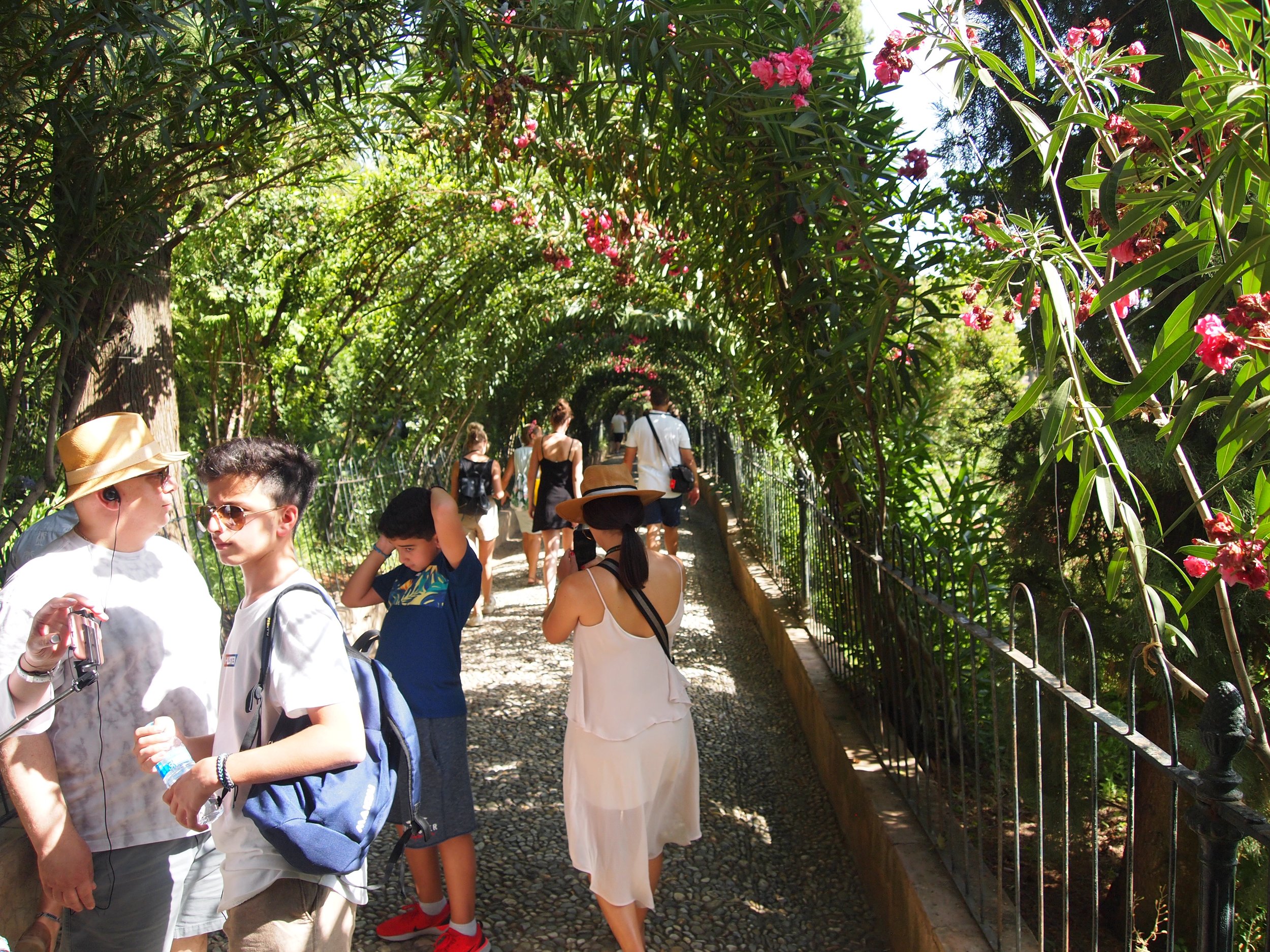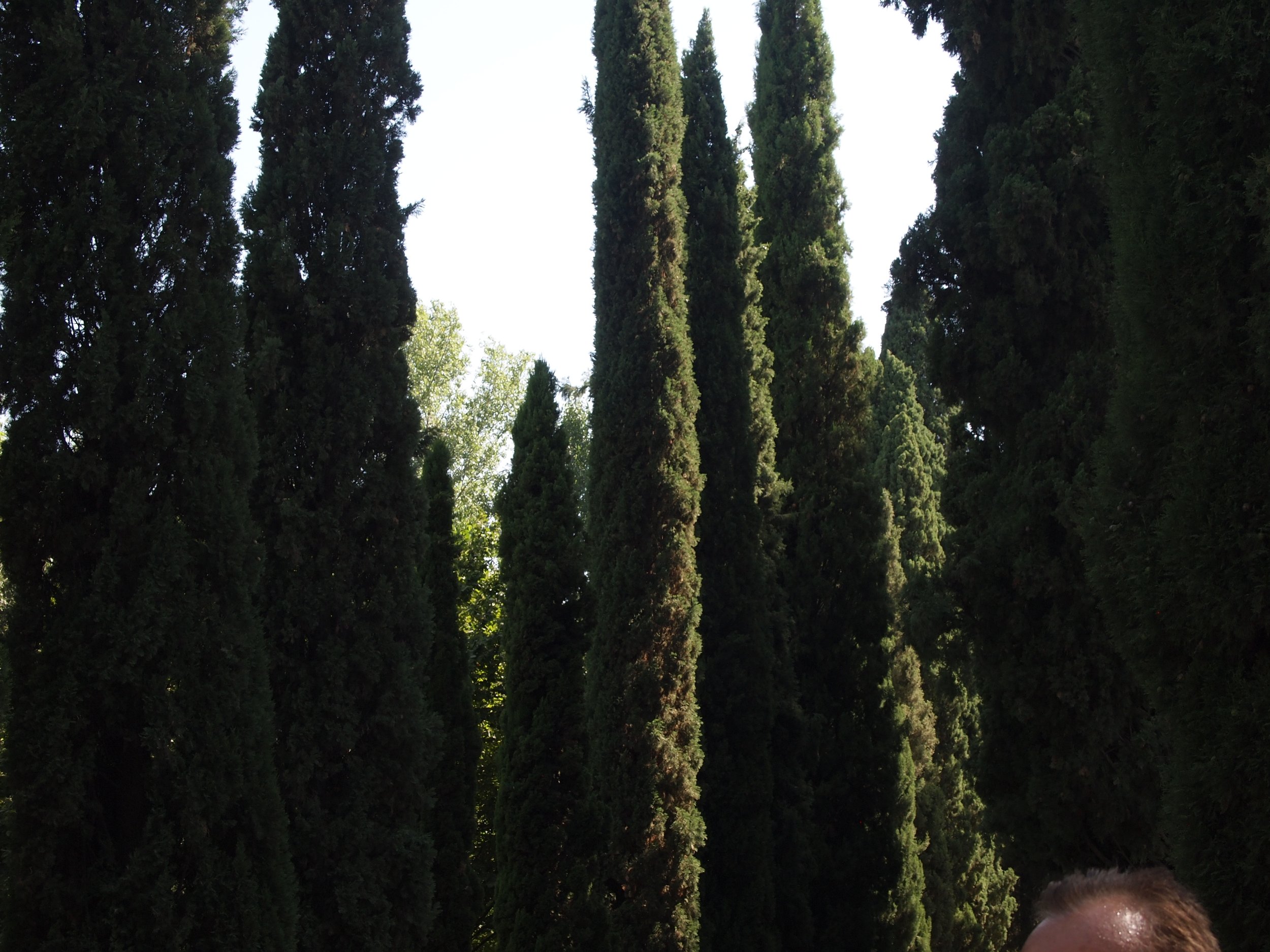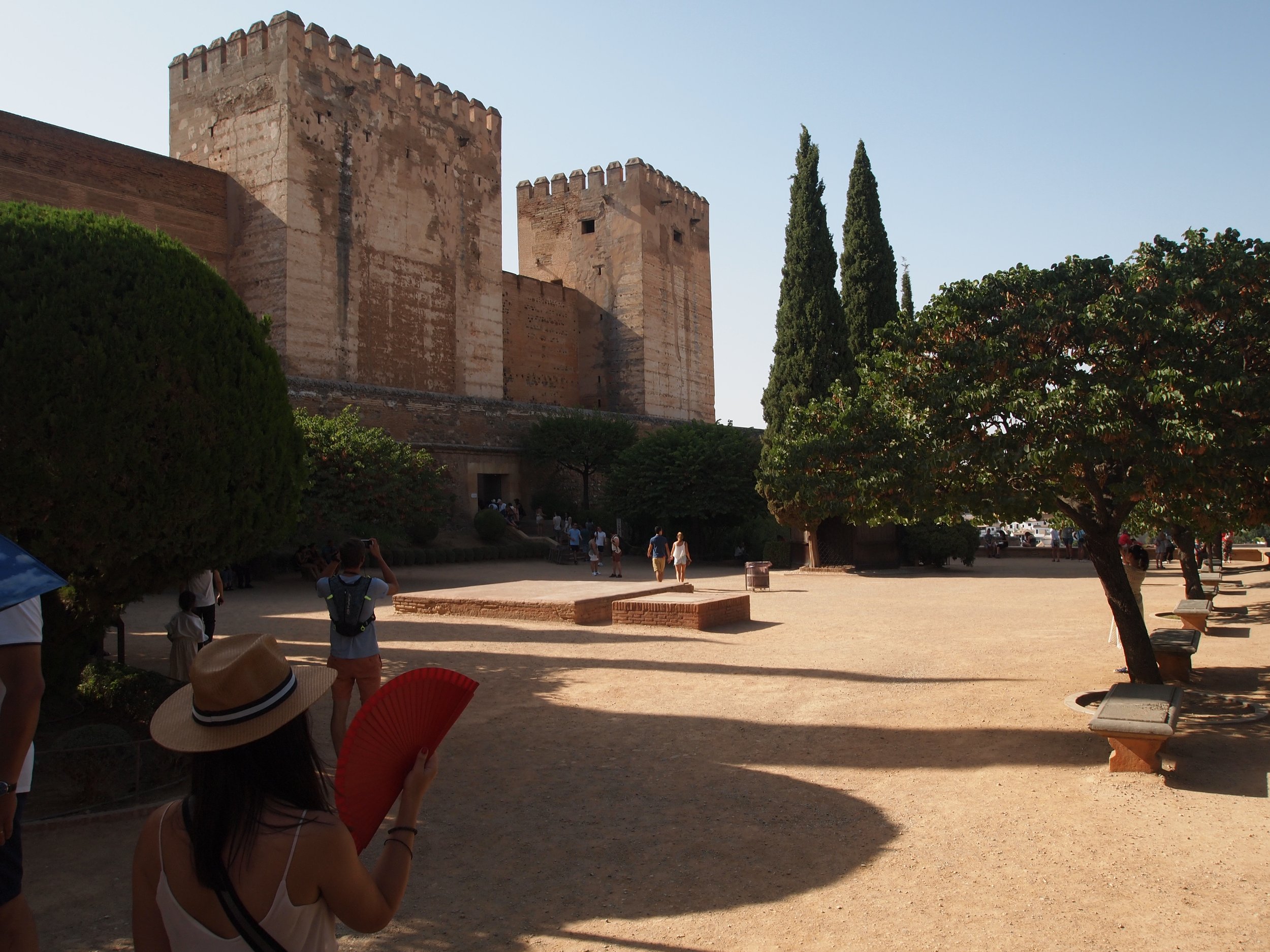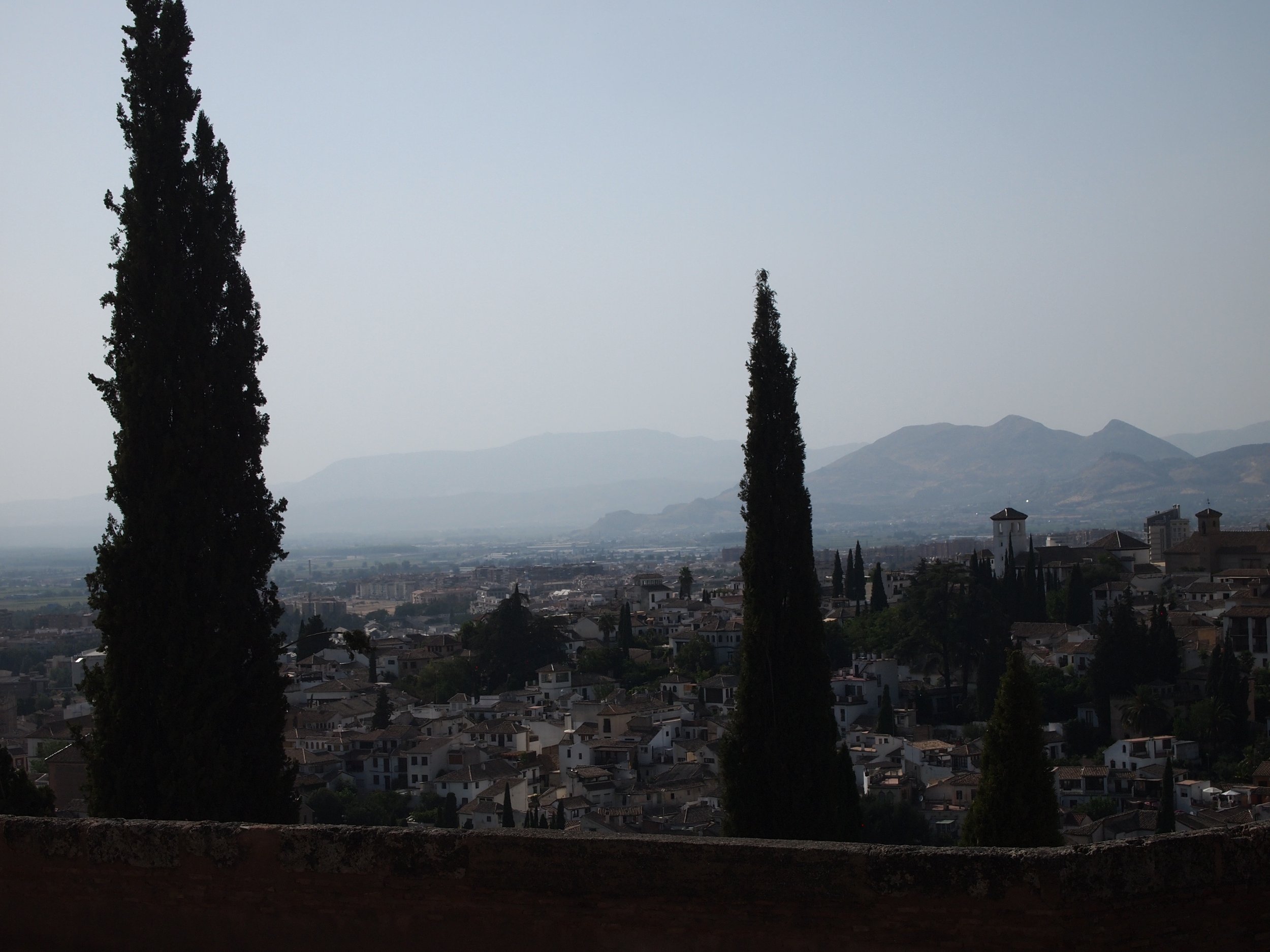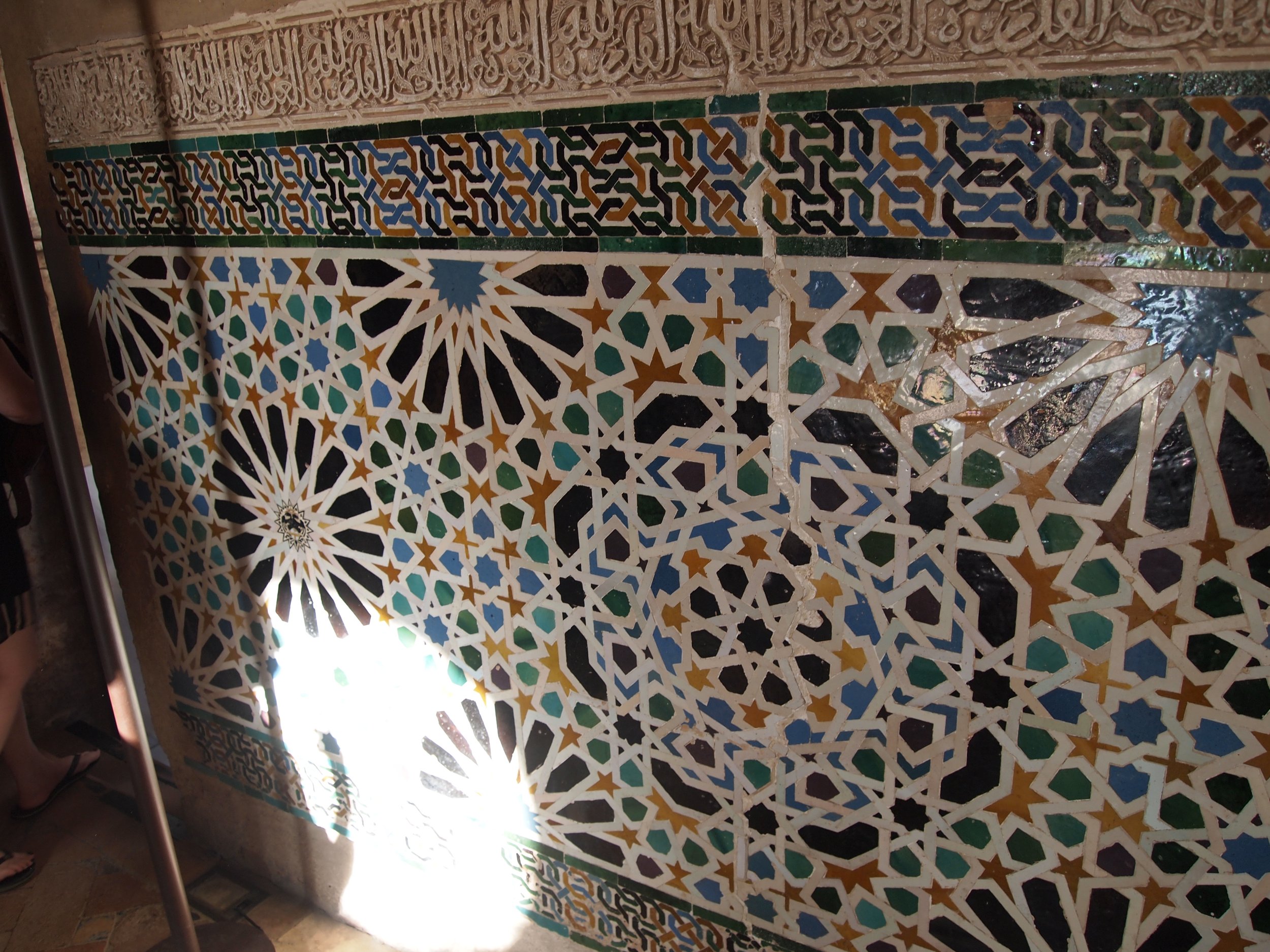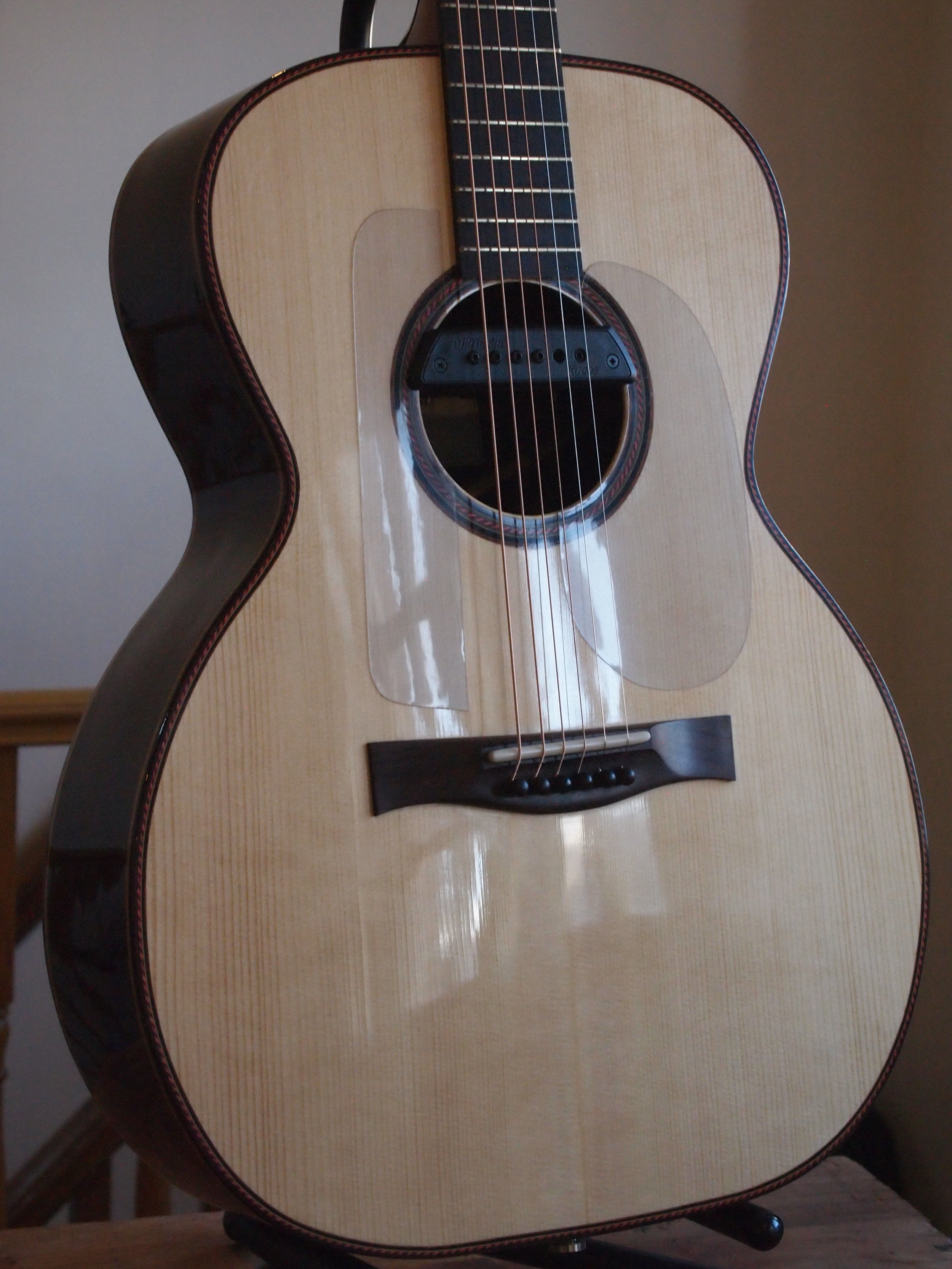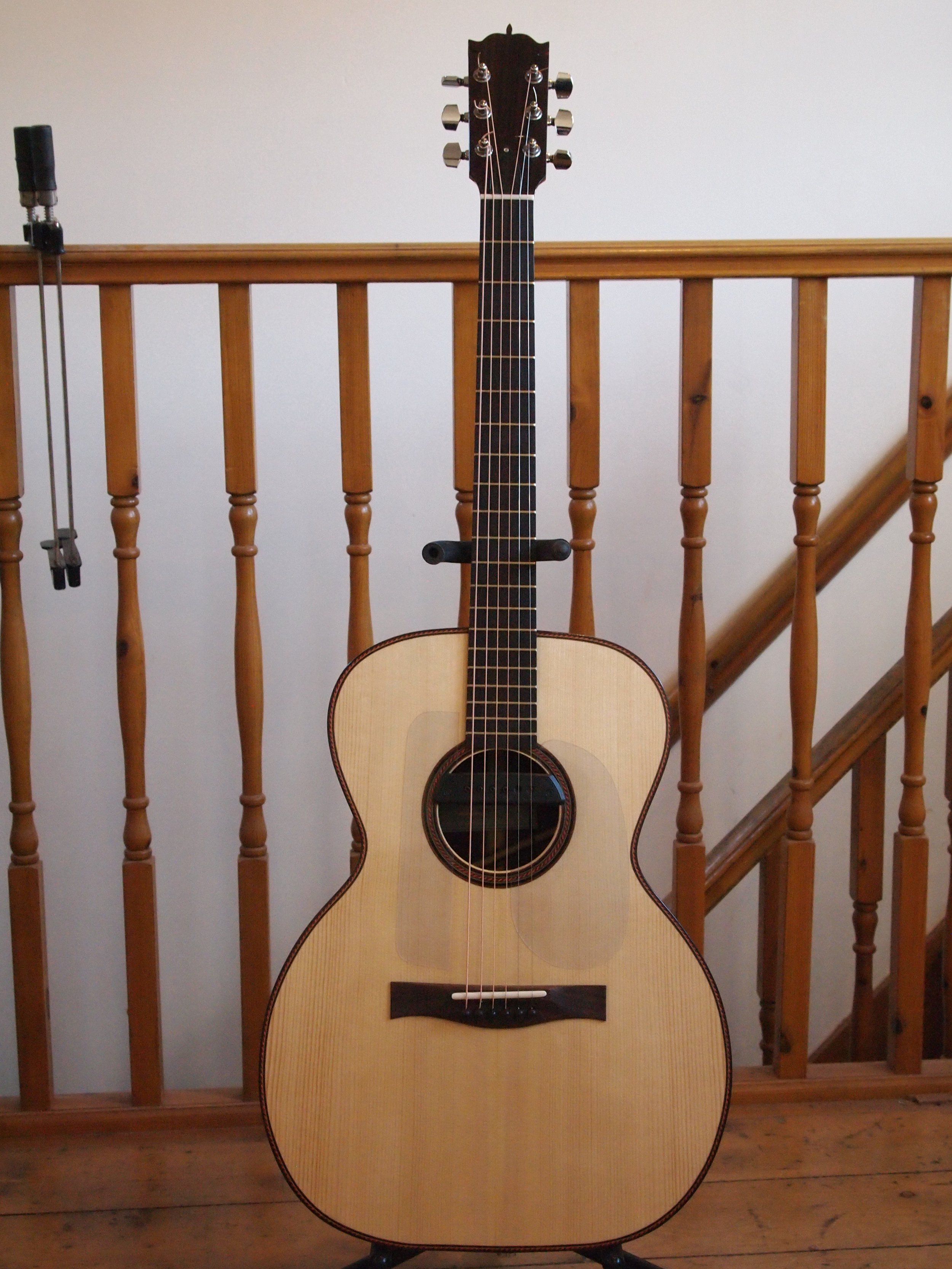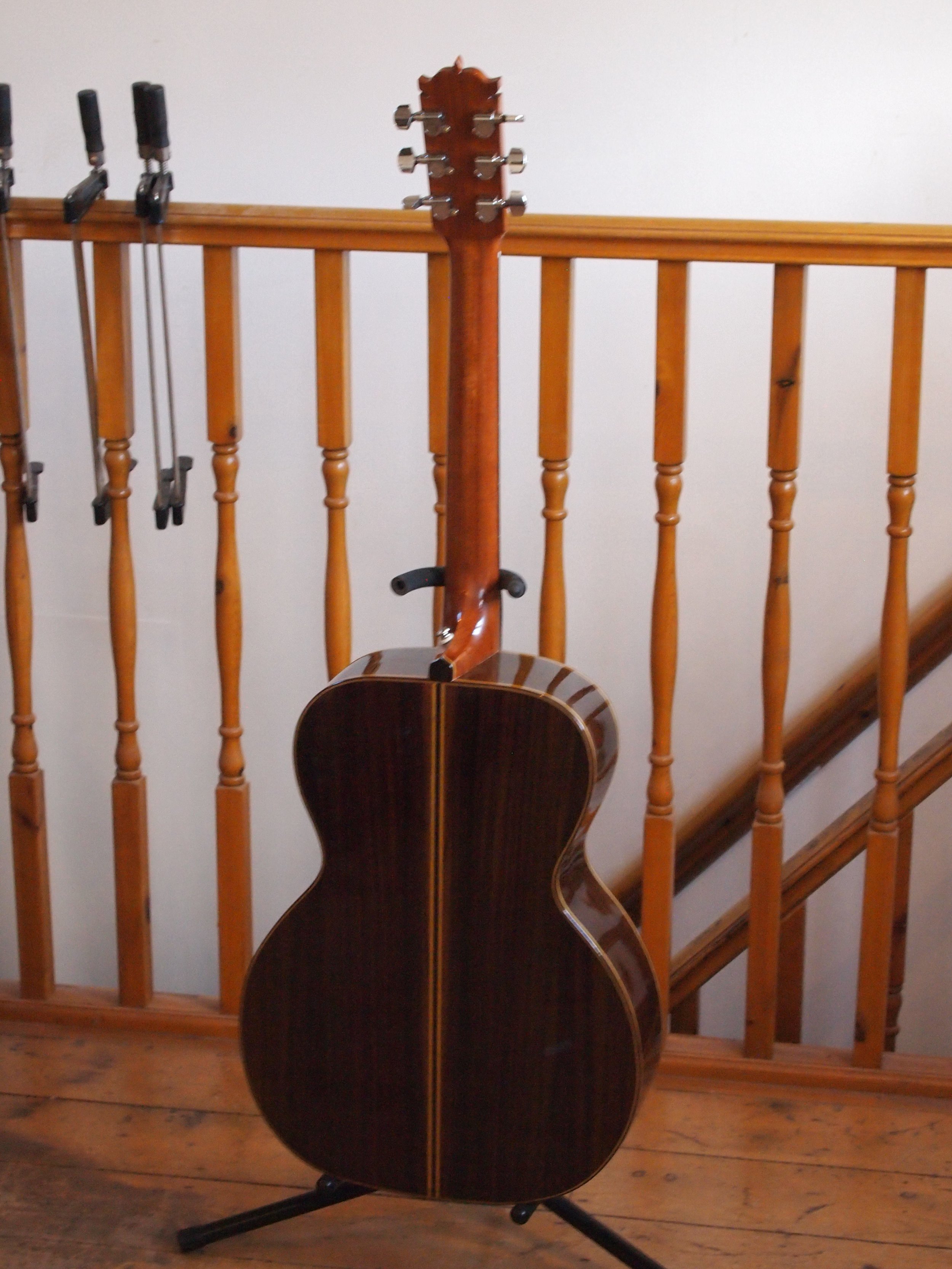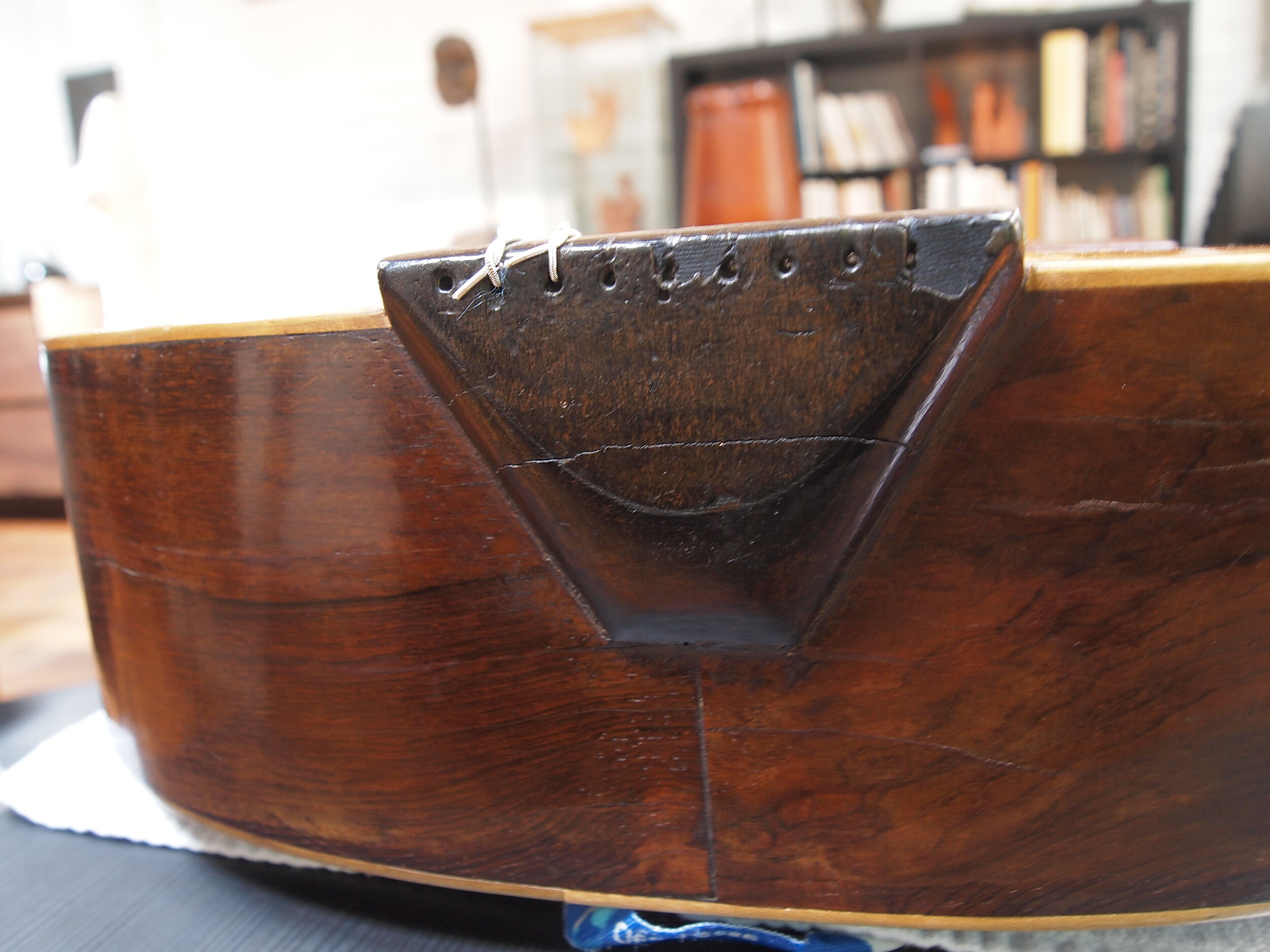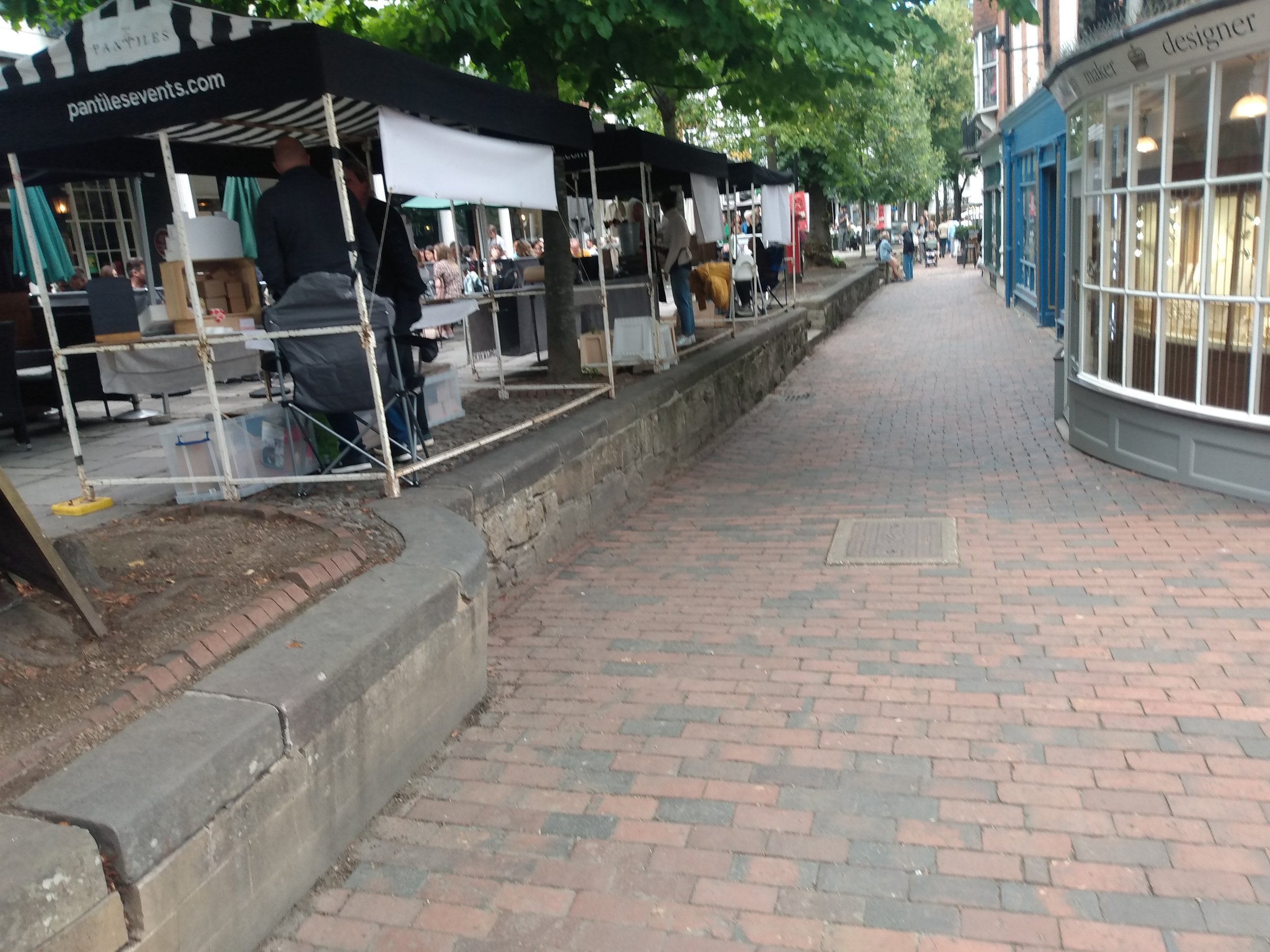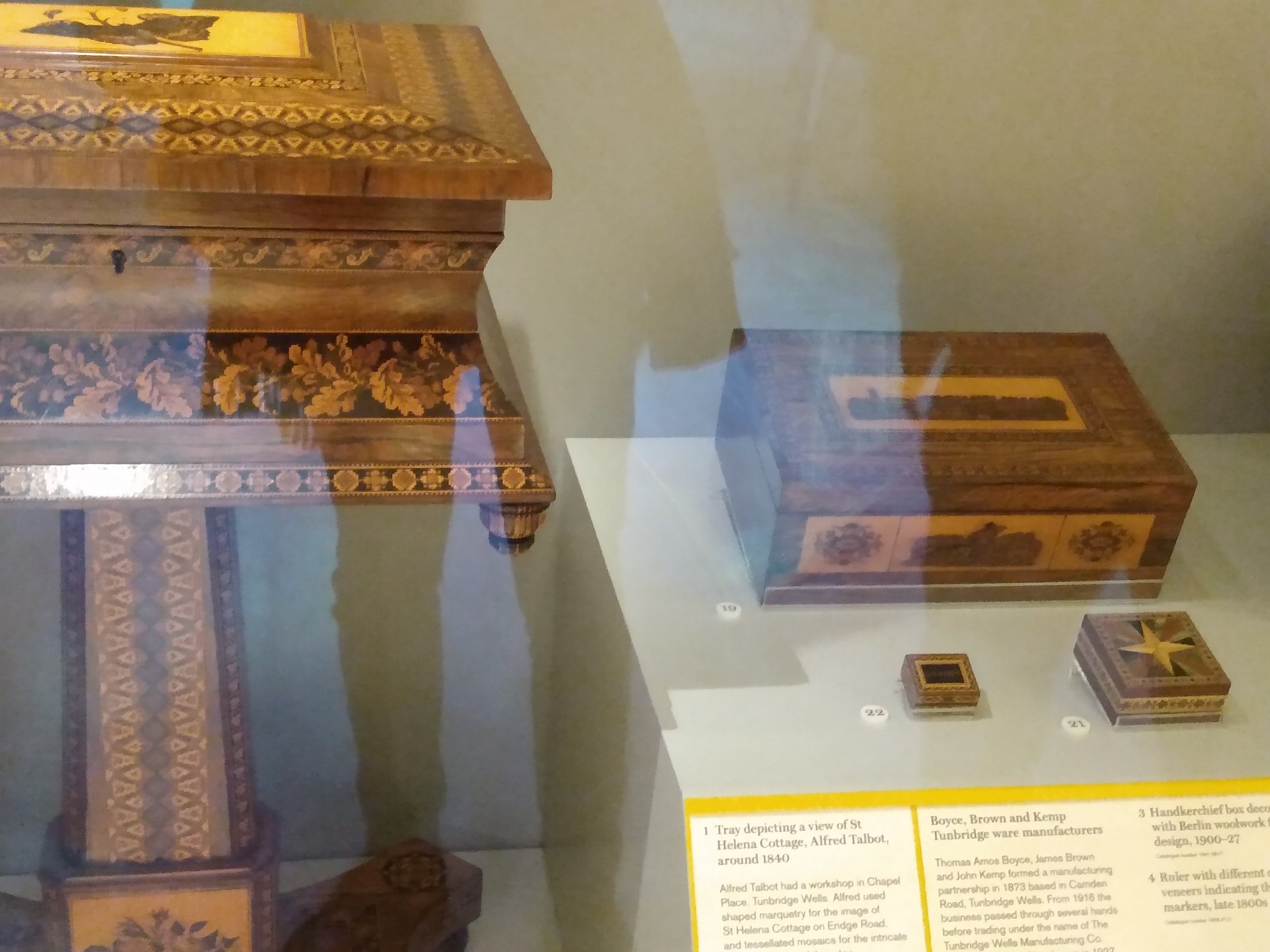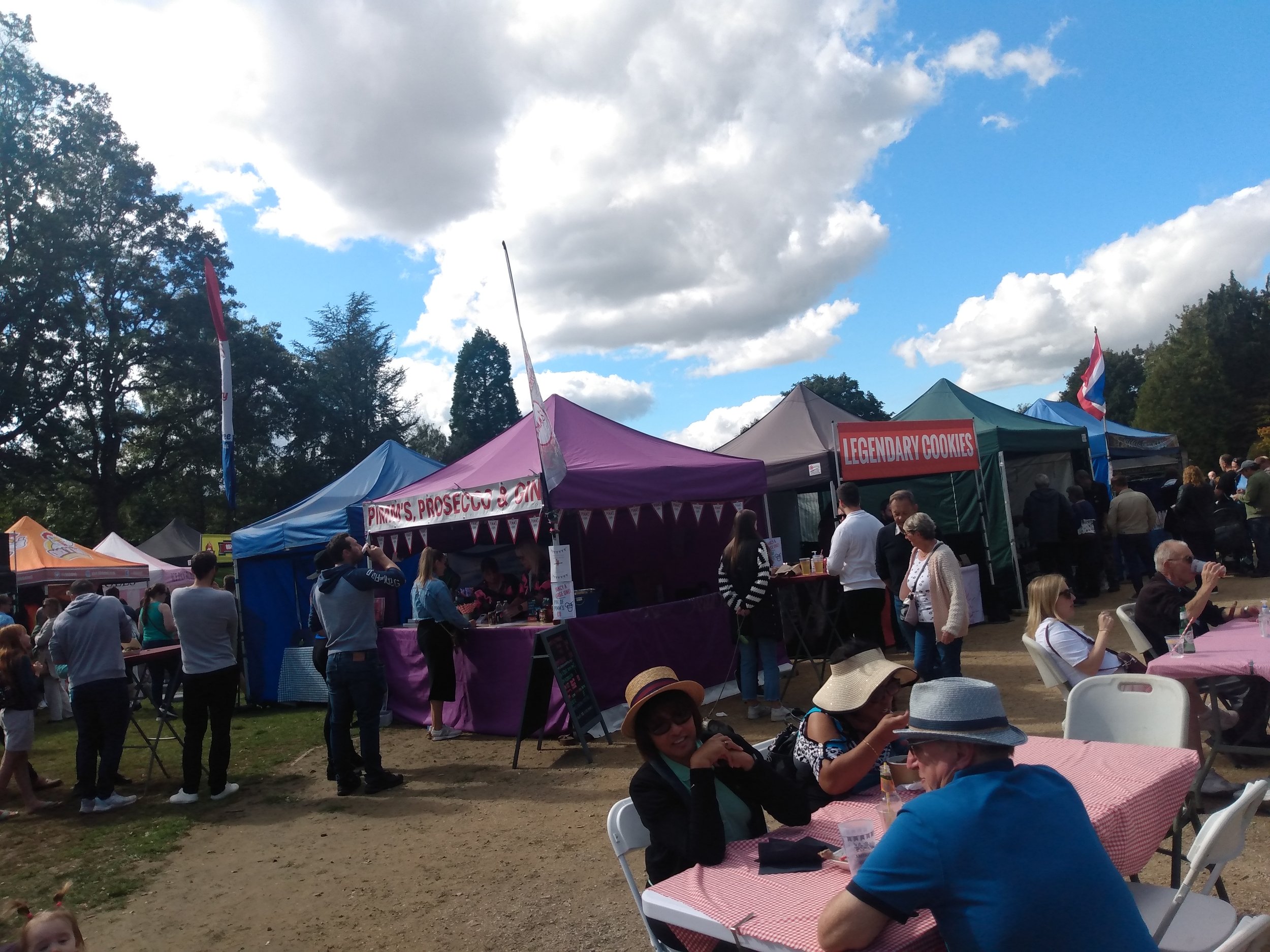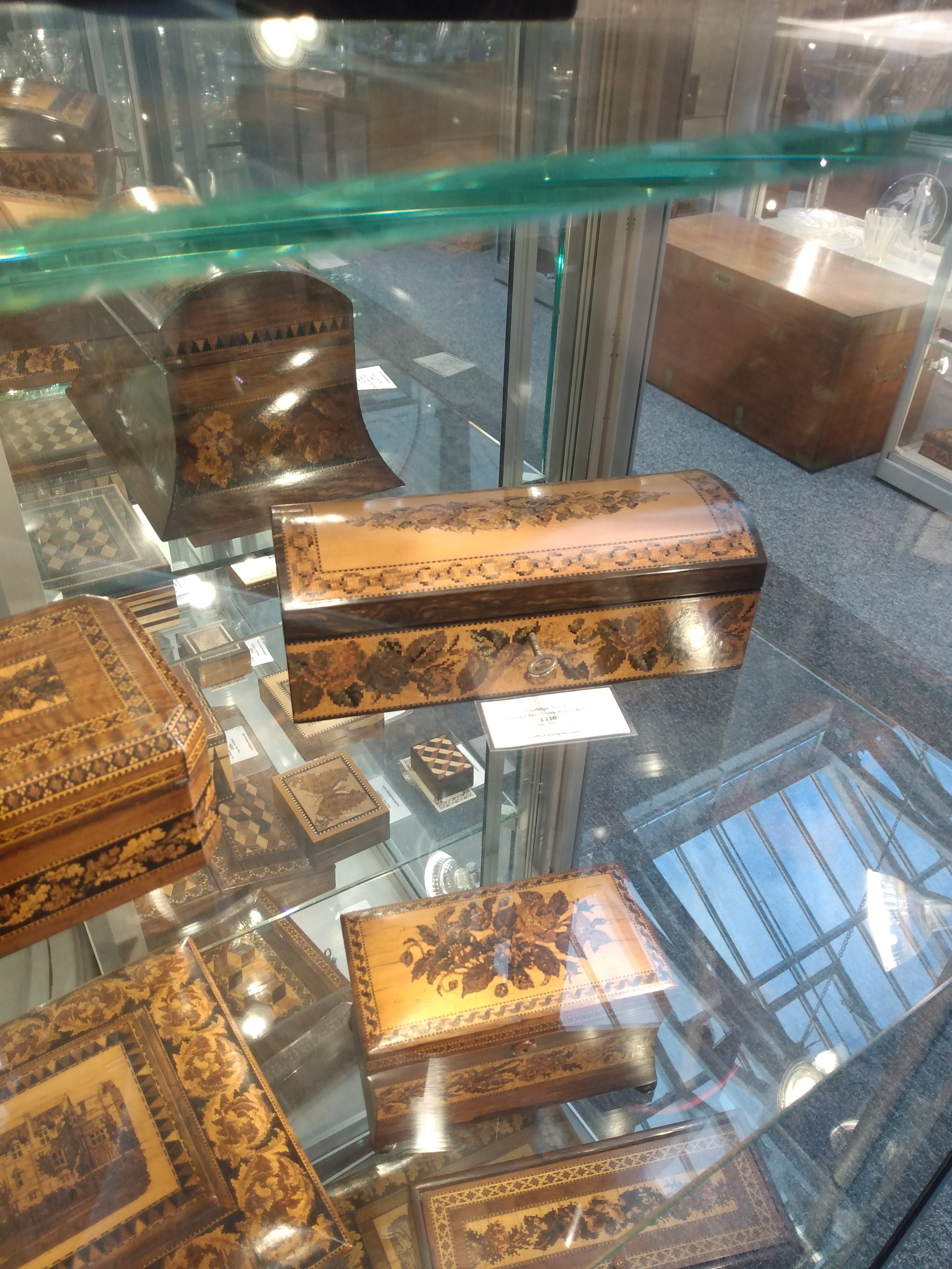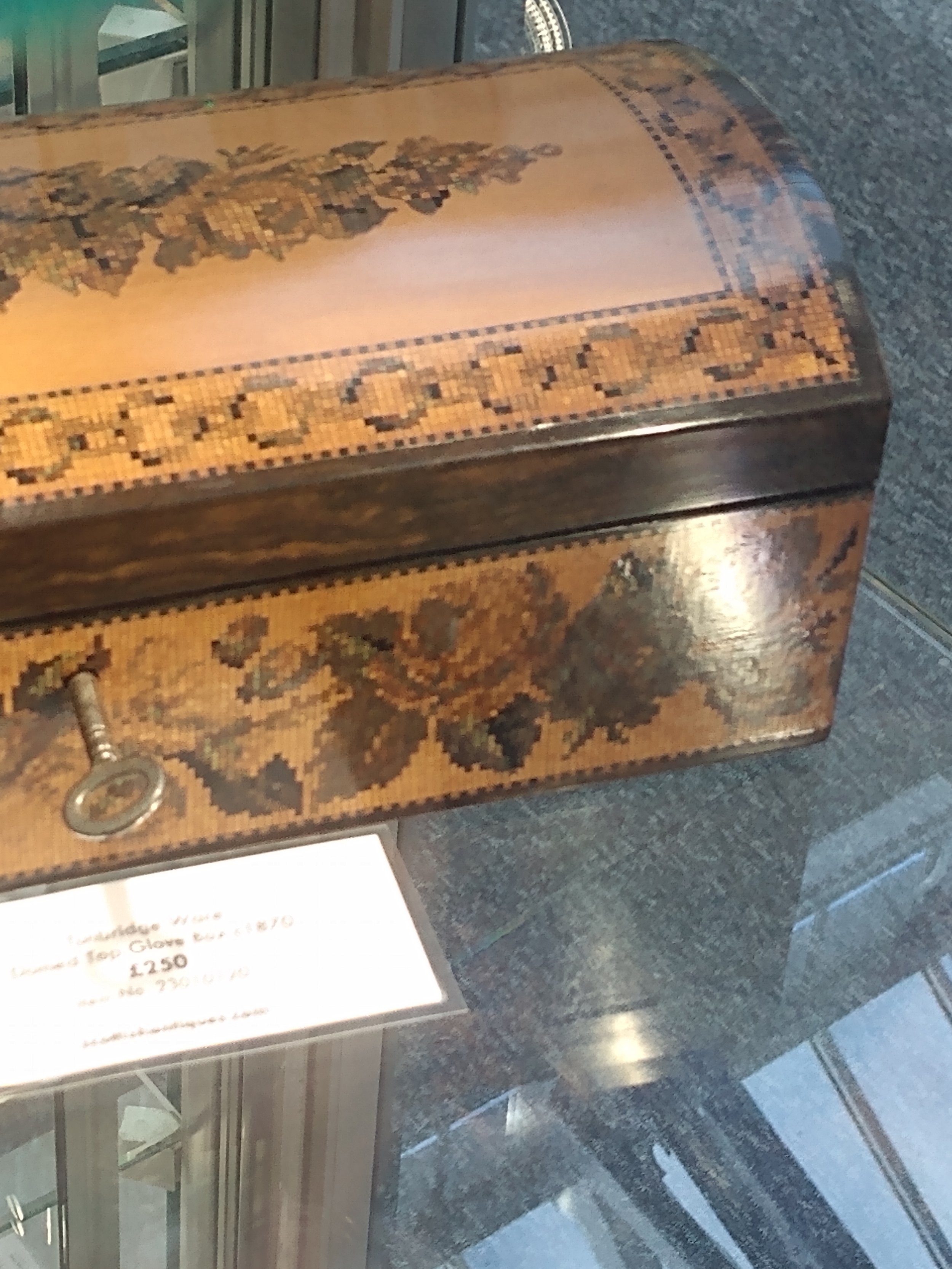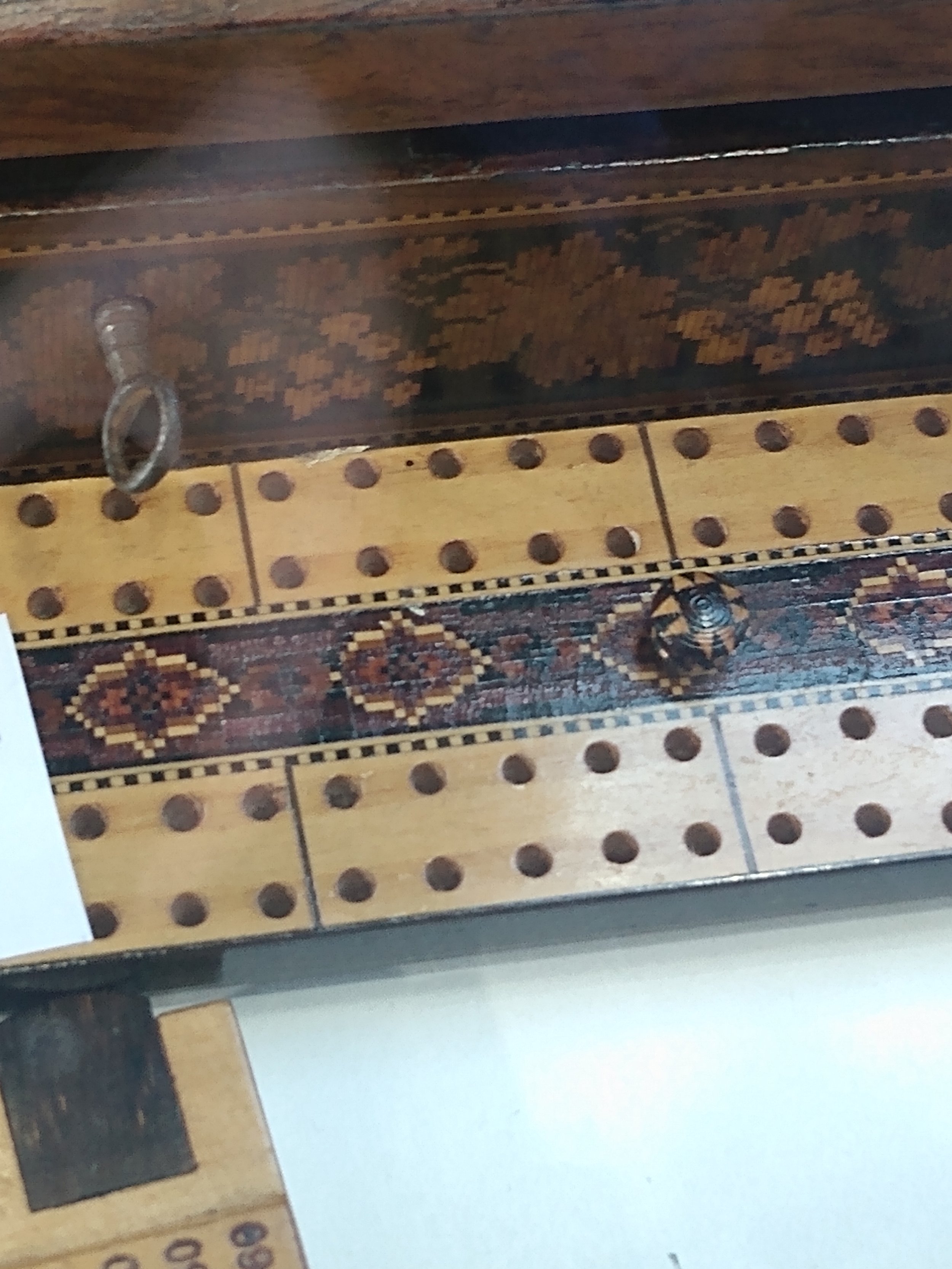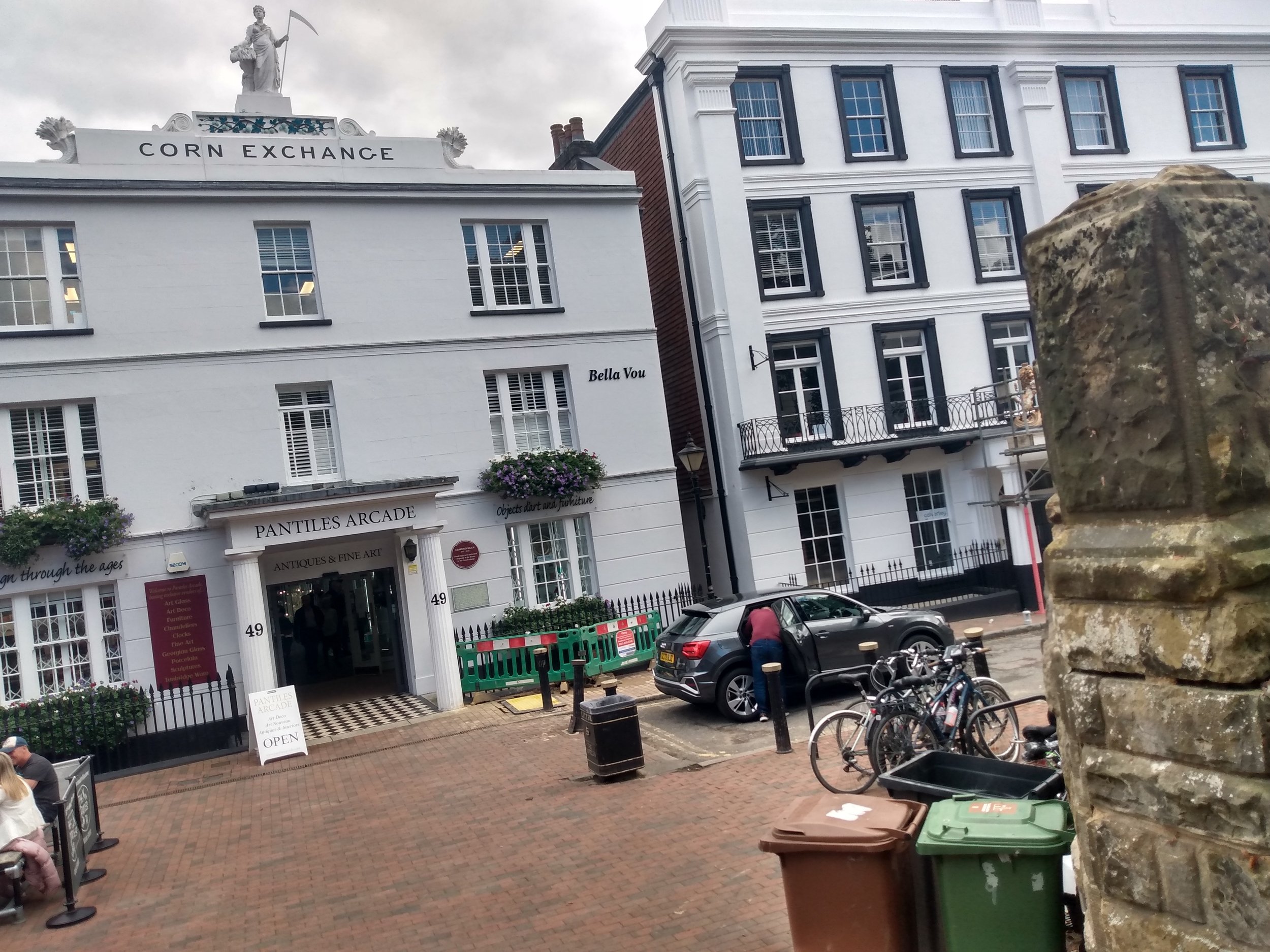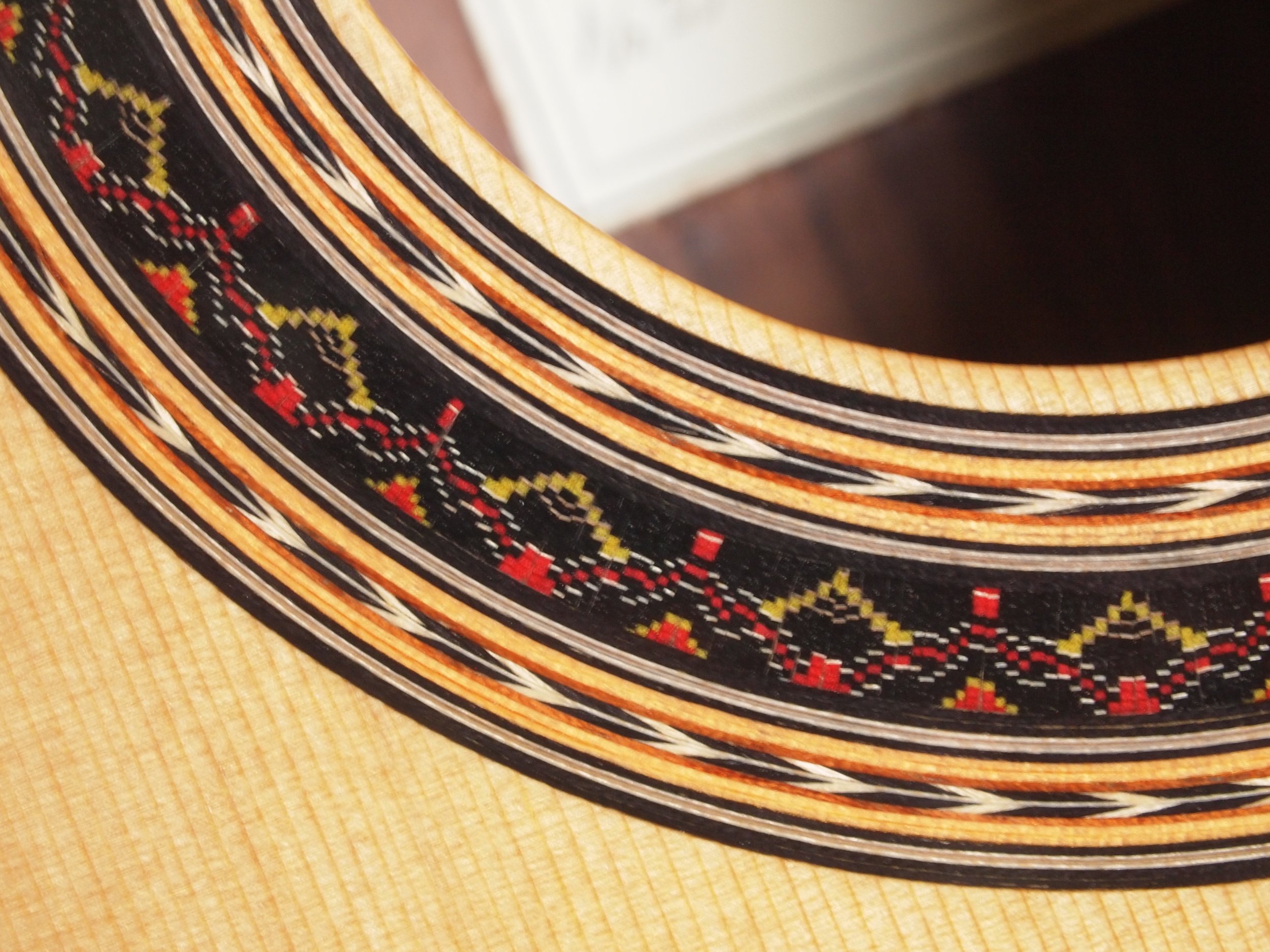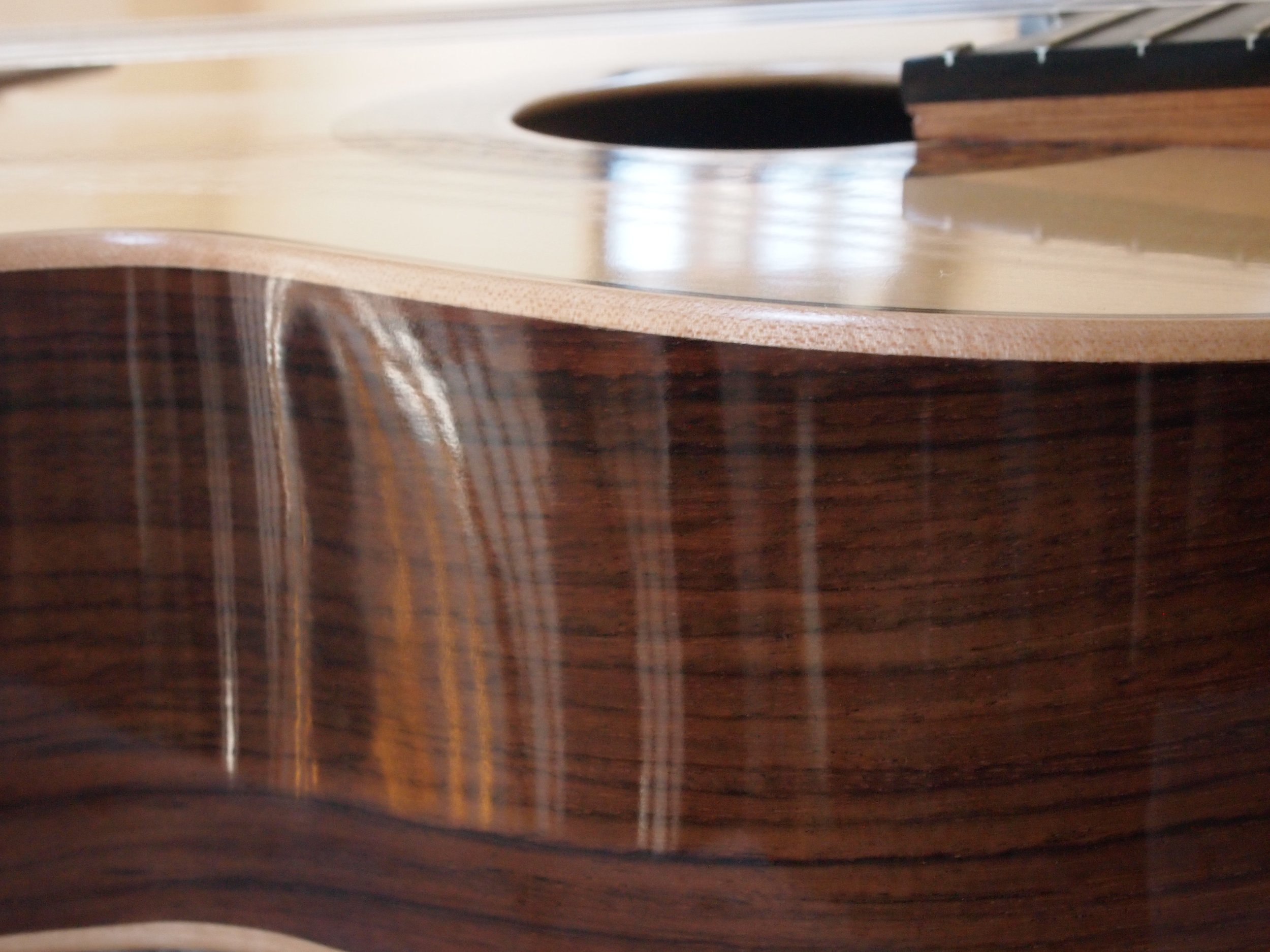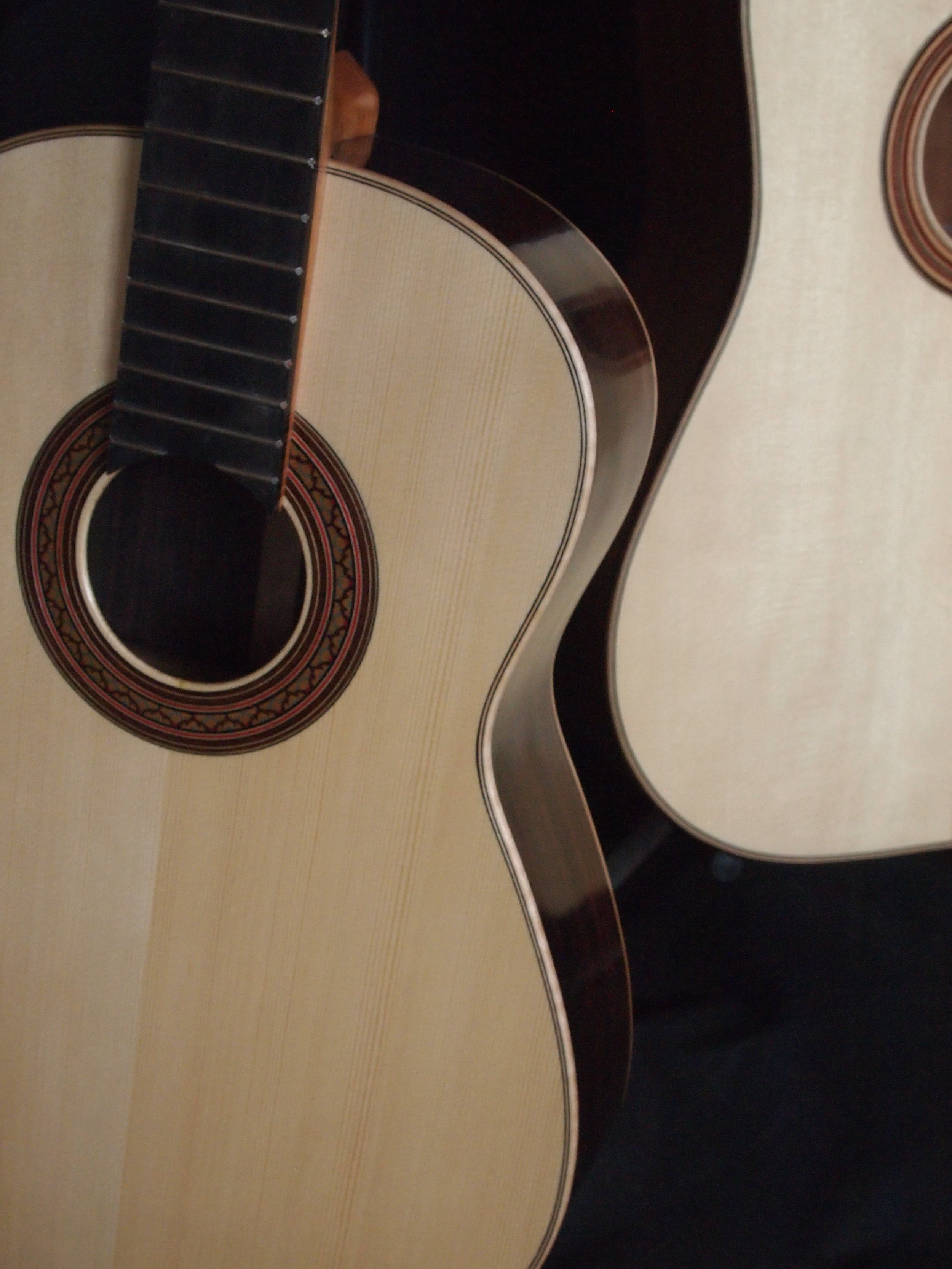Perfection
Perfection. Is it possible? Does it exist? Is it worth striving for? It can seem like such a long, difficult road to reach one’s idea of perfection in any art or craft. Every different art has its own unique challenges. All require passion, a bit of talent and, most of all, lots of hard work to overcome.
My thoughts dwelled on the subject of perfection on a Sunday evening, riding the train home from Bognor Regis, where I had watched the last part of a competition for classical guitarists, at the Chichester Festival of Music. I was really moved by many of the performances there; the sheer love of the guitar, the evident ambition for excellence, and most of all, by the fact that sometimes, the most stirring performances had their imperfections and mistakes.
I have reached a stage in my guitar making where I am redoing anything and everything - any small mistake of workmanship - until I’m satisfied that my work meets, or at least almost meets, my idea of perfection; so that every guitar leaves the workshop perfect. For classical guitars in my price range, it is genuinely important. I think it’s the right approach; often I learn a great deal in the act of redoing a task. However, at the same time, sometimes I feel crazy, spending what can seem like forever redoing tasks, repairing ‘mistakes’ that perhaps no one would have noticed anyway. It can be difficult to find a balance between seeking perfection, and obsessing to the point of counter productiveness.
At the Chichester Festival of Music, it was wonderful for me to see people on a similar artistic journey, and particularly interesting to notice that some guitarists were dissatisfied with their performances that I had enjoyed so much. It made me remember some ideas and philosophies that I know will help me in my path towards excellence in guitar making. For example, as a kind of salve for anyone on a similar quest for perfection, there is the Japanese philosophy of wabi-sabi (nothing lasts, nothing is finished, nothing is perfect). I also reflected on the fact that I often prefer an artist’s, author’s, or guitar maker’s early work, while they are perhaps still struggling to define who they are and are not yet a master.
An example from my own work
I’ve just finished redoing the lacquer on the sides of an upcoming guitar. The guitar could have been finished a month ago, but I was unsatisfied with the job I’d done filling the grain. (Some woods have deep grain that needs to be filled, to create a perfectly flat surface for polishing). The grain needs to be filled with a filler that compliments the colour of the wood. After completing the varnishing process on this guitar, and looking over the guitar in the sunlight, I felt that the filler I used actually detracted from the beauty of the wood. I felt particularly bad as the wood had been given to me by the luthier Rik Middleton, who confided to me it was his favourite kind of wood. Aiming to follow my own principle - that the closer you look at a guitar, the better it should get - and wanting to do Rik’s favourite wood justice, I removed the varnish and tried to solve the issue. It actually took about three tries and a few weeks! it was a struggle but the issue is now solved.
Was it worth it? Would anyone have noticed anyway? Now that it’s fixed I feel much more confident about the guitar and the standard of my work. I also learned a great deal in the process of fixing it, not only about the problem itself, filling to grain, but other things too. For example, during the long process of fixing the grain issue, I ran out of 2-inch brushes, and was forced to apply the lacquer with a 1-inch brush instead. I’d have thought this would be too small, however I was delighted to discover that I could achieve a more even layer of lacquer with this size brush.
I think my conclusion here is that although no, I don’t think any guitar player would have noticed anything wrong with the grain, I do think in this case, the relentless pursuit of excellence has improved me as a maker. I’m sure it won’t be the ‘perfect guitar’, but it will be the absolute best I can do at present.
Striving to do one’s absolute best is a far better goal than striving for perfection. Any artistic creation that is unique, imbued with character and passion is far more impressive than something perfect. I greatly enjoy reading, but there is not one single perfect book in existence. Perfectionist tendencies can become too much, and can cause a person to enjoy their passion less. Such tendencies work best, when the artist pushes themselves to do their best, but at the same time is loving the process, recognising that really, nothing is perfect and in the grand scheme of the universe, it really isn’t that important. I would say that most artists must have in their brain, in a state of flux, a cocktail of not only perfectionist thoughts, pushing them to do their finest work; but that the healthiest artists also have, in balance, wabi-sabi type ideas, compassionately mitigating the perfectionism.
Examples of perfectionism in other arts
There are a few composers I know of with some marvellous pieces but a very small output. One example is Maurice Durufle; he wrote some beautiful pieces, such as an amazing organ suite, a requiem and sets of motets. And although his perfectionist nature led to these marvellous works, it did inhibit him from writing more, and he couldn’t appreciate his own, wonderful, fantastic work. So he was constantly revising and updating his work, even after publication.
Apparently the artist Leonardo Davinci was a notorious perfectionist, leading again to a smaller output and many unfinished works.
Sometimes it’s good to look at examples of bad art, a painting, or to read a poorly written book, or watch a bad film, to remember that some level of pride and perfectionism is important; only it should be in balance, there but in a healthy way.
Tools against perfectionism. What is wabi-sabi?
Wabi-sabi is everywhere in Japan, having imbued the culture for many centuries. It is difficult to translate such a deep idea into English. My first encounter with the idea was the phrase, ‘nothing lasts, nothing is finished, nothing is perfect’. It is an appreciation of the beauty in imperfection, in impermanence, of the effects of time on a beautiful thing.
I think in western culture, we perhaps don’t realise how much we idolise perfection. But nothing in nature is perfect! In regards to guitars, I don’t want to put down good workmanship (I’m a victim of perfectionism myself when it comes to my own workmanship) but far more important than that, are elements such as style, character, meaning and depth. Workmanship/technique alone doesn’t move peoples’ emotions.
When I think of wabi-sabi, I think of my Grandpa’s guitar. I can picture it leaning against the curtains in my grandparents house, next to the back door leading into the garden. The vivid greens of the garden and blues of the sky are a bright splash of colour against the warmth of the living room, and the light of the garden frames the guitar. The guitar is more than 50 years old, its soundboard cracked in many places, aged a golden brown, its polish a beautiful patina; it has probably been knocked over more than a few times by the many grandchildren; it looks so comfortable - at home. In a way that a new guitar never would.
Visiting the Chichester Festival of Music Guitar Competition:
I ought to describe the event that led me to this deep-think on perfectionism. I had asked if I could display a guitar of two at a guitar competition at the Chichester Festival of Music. I have found that there are pockets of classical guitar communities, people who really passionately enjoy the guitar, not only around the country, but around the whole world. It’s lovely to seek out these communities and meet the people, and bring along with me my work; I find it really informs my guitar building. I really learn a lot from these events. This Chichester Festival of Music competition was actually held in the town of Bognor Regis, near Brighton.
I didn’t grow up learning the classical guitar, and hadn’t attended any guitar competitions before, so didn’t really know what to expect. I have been to three competitions for guitar makers. They’ve all been brilliant learning opportunities, forcing me to push the boundaries of my work to new levels, see what other people are doing, and network amongst people with similar passions and goals. I have found however that I’ve always been too nervous to properly enjoy the experience.
The Chichester festival of music, and there on the blue table is an Edgeworth guitar on display.
At this competition, there were different categories that guitarists could enter, and prizes for the best performances in each. After each category was over, the adjudicator would give the players feedback and award the prizes. The event was marvellously hosted and organised by Sasha Levtov, a true force of guitar nature, who is not only a lifelong guitarist, but has inspired many of England’s classical guitarists as a teacher; whose sheer presence in the room and brilliant nature noticeably eased the nerves of all who were to perform. The event was adjudicated by Paul Gregory, who teaches and also sells guitars; when he was giving feedback to the players on the performances, it was such a delight to hear the outpour of musical passion and knowledge, so articulately expressed, even though I’m sure it must have been nerve-racking for the players. Sometimes he would talk about the history of a piece, and the composer’s intention, casting a whole new light on the piece just performed.
I didn’t attend the first day but arrived around noon on the second day, sitting next to Connor and Ivonne, who were to perform in their guitar trio later. I noticed the hall was an interesting shape, it seemed to have been built for chamber/guitar music. It was great to hear the range of different guitar sounds, see the different playing styles of the performers, and notice their different song choices. Everyone did fantastically, I was filled with admiration for them all. It also makes me more intent to actually play guitar more, so at similar events I might be able to play something small, and at least share in the vulnerability of performing, instead of just observing.
I particularly enjoyed Ian’s performances of some classic Spanish pieces, especially Granada by Albinez. I also loved Joe’s pieces, and for days after, the piece that stuck in my head was the Cancion from Suite Compostelana by Federico Moupou, which I’m fairly certain was played by Joe. He also had an interesting guitar; it was loud and he got a lovely tone with it; I thought his instrument seemed powerful in an uncontrollable way, like a big beautiful kite in a storm, so Joe had to keep it under control. This idea added a sense of story and drama for me and was my favourite performance of the day. I loved the tone quality and the arrangement in Connor and Ivonne’s (and one other person’s) guitar trio. A funny moment was when the adjudicator Paul had awarded Linda a prize for an awesome performance; he looked closer at the trophy, and in surprise noticed and read aloud just how many times Linda’s name was already inscribed as winner on the trophy, going back over 20 years. There is something magical about the classical guitar that inspires such lifelong passion and interest, and it really happens all over the world.
In conclusion
The drive for perfection can result in amazing work; it is of course important to always try to get better and better. But perfectionism unfettered can stifle enthusiasm for one’s work, and stall progress. I think perfectionism mixed with a wabi-sabi philosophy might just be a winning combination towards excellence in art, promoting both quality of work as well as compassion for oneself as an artist. Listening to the guitarists at the Chichester Music Festival, with my limited knowledge of actually playing guitar, I could just listen and enjoy without worrying about the small elements of technique that the players were probably obsessing over. Instead, I was wonderfully moved by the music, and amazed at how they had developed this amazing skill to such a high level. I saw my passion mirrored, and think people probably view my art in a similar way to how I viewed theirs.
What are short scale guitars and who are they for?
I was in my early 20s, and I was about to begin making my first guitar for several years. I was excited, but at that time, the prospect of making a guitar also seemed like a monumental challenge. Having heard that there was a guitar concert happening in a nearby village, I set off on a winter's evening by train to a village called Stewartby, in search of some inspiration. I definitely found it. The guitarist was Valerie Hartzell. As I listened to her play, I knew I was hearing the full potential of the classical guitar. I could picture what I wanted my own guitars to sound like. It was a game changing concert for me. Unbeknownst to me at the time, it was also my first encounter with a short scale guitar.
Here Valerie plays her Greg Byers guitar. It can be seen here that a 630mm guitar doesn’t seem noticeably smaller than a 650mm guitar.
Valerie played a 630mm guitar built by an American guitar maker called Greg Byers. Usually guitars have a scale length of 650mm - that’s 650mm from the nut to the saddle - anything shorter than that is considered ‘short-scale’. Since 650 is considered full sized, it may not occur to many guitarists that other options may be more suitable for them. If you consider the wide range of heights and hand sizes amongst men, women and children, it really doesn’t make sense that everyone should use the same size guitar. And as shown by Valerie’s performance, which has inspired me throughout my whole career, it is more than possible to make a real impact with a short scale guitar.
How many classical guitar sizes are there?
Any scale length is technically possible. 650, as I mentioned, is full sized. 630 is a common length for a short scale guitar, the difference is noticeable but still subtle. A scale length of 610, or more precisely, 613.5, is the length of a full size guitar with a capo at the first fret. In case you are reading this in 2024, my next two guitars, in early Spring, will have a scale length of around 613.5mm, so if you are curious to try such an instrument, don’t hesitate to get in touch.
Smaller instruments than that are of course possible. I recently watched a guitar orchestra performance; as well as normal guitars, they had massive guitars with their strings tuned an octave lower, and smaller guitars with their strings tuned higher. On the larger side of things, 660mm instruments aren’t uncommon. The largest I’ve tried was 720mm, details of which you can find here: https://www.michaeledgeworthguitars.com/en/blog/a-marvellous-and-historic-instrument
Guitar sizes are particularly confusing because different people use different units of measurement. Here’s a table to simplify things a bit, with the size, an then the corresponding scale length in inches and millimetres:
4/4 (Full size) -650mm - 26”
3/4 - 580mm - 22.8”
1/2 - 535mm - 21”
1/4 - 480mm - 19”
On the design of smaller instruments
There are some difficulties for guitar makers when building a shorter or longer scale instrument; to a degree the whole instrument has to be slightly redesigned. For example, if the scale length is shorter, the guitar’s bridge needs to be closer to the soundhole. That can look strange if the guitar maker isn’t careful. To avoid that looking weird, the guitar’s body needs to be made slightly smaller. Another such adjustment is the bracing. A smaller guitar will need lighter bracing, and higher tension strings.
One thing that tends to stay the same on a smaller guitar is the width of the fingerboard. On a regular guitar, the fingerboard is 52mm wide at the nut and 62mm at the 12th fret. If the fingerboard is made much narrower than this, the instrument quickly starts to become difficult to play, as the strings are simply too close together.
I think a huge advantage of handcrafted guitars is that it’s possible to find the ideal instrument for you, something that not only sounds amazing, but fits you like a glove. The scale length of an instrument is definitely a part of that and shouldn’t be overlooked. A skilled guitar maker would be able to make the small adjustments in bracing and design to make a smaller instrument sing, despite the difference in size and string tension. Just as Greg Byers did with Valerie’s instrument. I spoke to Valerie later about her guitar. I remember it as being really powerful! She said that Greg was displaying it at a guitar festival in the US, where she tried it and decided it was the instrument for her.
Torres, considered the father of the modern classical guitar as we know it, built many smaller instruments. The same for earlier makers, such as Lacote and Panormo.
What about guitars for children? What size classical/flamenco guitar should I buy for my child?
It can be difficult to find guitars for young guitarists that are made with the same care as full sized instruments. However, with the right instrument, any young guitarist will be far more enthusiastic to pick up the instrument, and avoid any bad habits caused by an unsuitable guitar.
If possible, the best way to find the right size would be to try out several sizes and see what’s most comfortable for them. In some cases, it’s possible for quite small guitarists to use a 650 or 630mm size instrument. Although the size of a guitar is measured by its ‘scale length’ (the length of the string from nut to saddle), another important factor is the size of the guitar’s body. Too big or small, or too deep, and the guitar can feel awkward and cumbersome to play.
There are some videos of a young Ana Vidovic playing a full sized guitar when she was very young, and the same with a young Xuefei Yang. On the other hand, I believe Valerie Hartzell told me that she visited the Ramirez workshop when she was a child, with her parents, and they bought a small Ramirez guitar, which she used throughout her childhood.
Classical guitars for adults are often finished with French polish. With kids, it might be a bad idea to use something so delicate, so a lacquer finish would almost certainly be the answer here.
I remember being about 8 and beginning to learn the violin, and I remember thinking how brilliant the violin itself seemed to me. I had one on loan from my school. It and it’s bow were so beautiful, I really wanted to learn how to play it! I witnessed the same with my two sisters, as they learned the piano and saxophone respectively. The glistening golden shine of a saxophone… it’s very alluring. I think for the same reason, it’s worth getting a guitar of reasonable quality for a young guitarist; something they are drawn to play. If they do grow out of it, they might still keep it forever. I think that Valerie, for example, still has her Ramirez guitar from childhood.
Some of my recent work
Over the past year or so I’ve reached an exciting phase of my guitar making career. The tangible and visible elements of my guitars - such as the aesthetics, workmanship and the different types of polishing - are really coming together, and I’m close to finishing development on my own signature model. Some guitar makers develop their ideal guitar design, and once that’s done, they spend the rest of their career basically building the same guitar over and over, refining it over time. With many guitars you can take one look at the rosette, headstock shape, or even type of finish, and immediately know who built it. I really like this way of working as opposed to building copies of older guitar makers’ work. But best of all, now that I’m satisfied with the tangible considerations such as workmanship, finishing etc, that means even more energy can be put towards the sound, which is the most important thing after all.
In this post I’ll describe some of my recent work. While I was building these guitars, I was thinking ahead to the design of my signature model. The focus of my attention shifted very firmly towards the sound. I actually took the first of these guitars to a guitar making competition. For that competition guitar, I had a really strict zero tolerance policy towards any aspect of workmanship that I was the slightest bit unhappy about. I re-did any small mistake, and I have kept this practice, and therefore every guitar that leaves the workshop has gone through a vigorous quality control regime. I thought I was a perfectionist before, but the standard is definitely higher now.
Before building these guitars, thinking very much about how to achieve a stronger sounding guitar, I sought advice from some master guitar makers. I visited the now retired Paul Fischer in Oxford with a couple of guitars, as well as Rik Middleton in Coventry, and was able to show a guitar to German luthier Gernot Wagner in a chance meeting in London. So I’ve tried to incorporate some of the principles that they spoke about. I’m really glad to have the hurdle of workmanship out of the way, so I can focus very much on the sound. Crafting sound is something so interesting, mysterious and intangible. When speaking to the guitar makers I mentioned, I got a sense of this mysterious art being passed along. I feel like not many such arts still exist in the modern world, and if they do, they’ve been made partly redundant by modern technology. Happily, this isn’t the case with classical guitars. The guitars I’ll describe below were all made with wood given to me by Rik Middleton. It’s extremely beautiful, aged forever in his workshop, and I did my best to do it justice.
A flamenco guitar, made from spruce and flamed maple:
The design:
For the design of my flamenco guitars, I began by using a plan of a guitar by Santos Hernandez, a brilliant Spanish guitar maker of the 20th century. He used a variety of bracing patterns, but this one uses seven fan braces and no closing bars. Over the years I have continually refined the design, seeking what works best for me and the guitarists I get feedback from. I think the resulting sound is quite sweet, clean, and old-school. Even suitable for some classical players. Guitars of this general design were used when there was less of a distinction between flamenco and classical guitars, so guitars like this particularly tend to suit Spanish music of the early 20th century, as well as flamenco music. For the body shape I used my signature shape. The rosette is handmade by me, the mosaic inspired by a pattern used by Spanish builders such as Ramirez and Gerundino. The headstock shape was inspired by Paul Fischer; although I like it, I have an idea to develop it further, so I think the next guitar’s headstock will be even better.
The wood
Flamed Maple - Rik bought the flamed maple for this guitar early in his guitar making career, from a retiring cello maker; maple is also used for the back/sides of the violin family, but the varnish used is darker. Rik used maple from the same set to build his very first guitar, and had kept the rest his whole career. My first two guitars were built using maple too, one with plain maple, and the other with birdseye maple. So I’ve always been a maple fan. Maple is also one of the three woods regularly used by the maker Torres - he mostly used rosewood, cypress, and maple - therefore it has always been considered a very traditional wood for guitars. This is a beautiful set and was a delight to work with. Sometimes, very figured woods like this can be a pain to work with, however for such woods I use a tool called a toothing plane, and then a cabinet scraper, and usually avoid any problems.
Some snakewood bindings being sawn. A beautiful but difficult wood to work with
Snakewood - For the bindings and some decoration on the headstock I used snakewood. Snakewood is a beautiful wood which grows in some coastal areas in South America. It's not endangered but it’s quite difficult to get in lengths long enough to use for guitar binding. It’s generally a pain to use; it’s very dense and difficult to work; it splits easily making it difficult to bend. Due to these problems it’s only really used in small strips and not for anything structural. I discovered snakewood from looking into Paul Fischer’s work, who used it quite often for binding and decoration. I used three complimentary pieces of snakewood to make up the headstock veneer on this guitar. I also used double strips of snakewood for the binding. This is a touch of workmanship I’ve seen in the work of several high end luthiers, including Paul’s, Gernot Wagner’s, and David Rubio’s. It gives a stronger outline/border to the shape of the guitar.
Ebony - For the fretboard a very black ebony was used. Due to environmental concerns, it’s difficult to find ebony so black. It usually has some grey streaks amongst the black. I did some research last year into the sustainability of guitar woods, and ebony is definitely a wood I want to only buy from verified sustainable sources. The other difficult thing about ebony is that it seems to shrink continually, resulting in protruding fret ends and sometimes cracks alongside the fretboard. Rik had kept this piece of ebony for almost 25 years, and on it had written its weight over time. So it was interesting to see how much water it had lost over time.
Spruce - Spruce is the wood I’ve used most for the soundboards of my guitars. Soundboards are made with two bookmatched pieces of wood and joined in the middle. This particular example was already joined when I received it. But it had a dark stripe down the centre line, which occurs when the two pieces of the soundboard are very aged even before being joined and they begin to darken around the edges. Although this dark stripe is actually relatively common is guitars and not considered a flaw per se, I decided to unjoin the two pieces, get rid of the darkened section, and then rejoin them.
The golpeador
I’ve detailed how I glue a golpeador here: https://www.michaeledgeworthguitars.com/en/blog/how-i-glue-golpeadors-to-flamenco-guitars . The shape of this golpeador was inspired by the fact that many flamenco players like to rest the thumb of their right hand on the rosette, sometimes gouging into the finish and wood. This one extends over the rosette on that side. Thanks to my method of applying the golpeador, it’s fairly invisible to anyone looking at it from any distance.
The finish
For the back and sides I used a kind of lacquer, and for the soundboard and neck, French polish. Amongst many of the professional players I’ve spoken to, the overall consensus has been that they would prefer French polish for the soundboard, as it’s the thinnest finish and doesn’t impede the vibration of the soundboard, but that something that doesn’t wear so easily would be for more suitable for the back and sides. I don’t like to use lacquer for the neck as well, because then I feel the guitar tends to feel less like wood, and perhaps too ‘plasticky’, so for that reason I French polished the neck. There are a variety of different finishes, all difficult to master. I like using the most suitable finish for particular parts of the guitar, and it also gives me a chance to show off my finishing skills.
A classical guitar, made from spruce and a wood called Palo Escrito:
I will update this picture shortly once I’ve taken pictures of the completed instrument
The design
I have been developing my concert guitar for a while, and the design has gone through many changes. A little over a year ago, I showed luthier Paul Fischer a plan of the bracing pattern I was using at the time. We talked it through together and we made some changes. As I mentioned, around that time I was also in touch with other guitar makers, and the guitar design I have now was greatly influenced by my discussions with them. In my earlier guitars, I got to a point where I could consistently achieve a sweet sound with a good tone, but perhaps lacking in volume and projection. Therefore, I have been aiming for a more powerful guitar but without sacrificing the good qualities in my earlier guitars. The wood itself is quite beautiful on this guitar so I’ve kept the decoration fairly minimalistic, to let the beauty of the wood speak for itself.
The wood
Palo Escrito - Rik mentioned that Palo Escrito might be his favourite wood for its sound properties. It’s also visually stunning; a beautiful golden brown, it’s called ‘Escrito’ because it has grain lines that resemble writing. It’s a type of rosewood. To contrast against the Palo Escrito, I used ebony binding.
The finish
This guitar has, in theory, the perfect combination of finishes. I have long said that if I were to build a guitar for myself, I would like French polish for the top, lacquer for the back/sides, and oil for the neck. So, I finally carried out my idea on this guitar. I also French polished the headstock. I think this combination of finishes takes into account all sonic, visual and tactile concerns.
Many agree that oiled necks feel amazingly slick. For me, French polish is not only visually the most beautiful, but it’s also probably the best finish for the soundboard as it’s the thinnest. I’ve also spent many years refining my method for applying a particular kind of lacquer; it’s a very tough finish and easy to take care of, so perfect for the back and sides. Every guitar finish has strengths and weaknesses; I think I’ve used each finish in the best way here.
Some upcoming work:
In the coming months, I’ll be completing some exciting work. Two short-scale guitars; they will be very special instruments. One will be my first lattice instrument. Both with spruce soundboards, one will have Indian rosewood back/sides, and the other Pau Ferro. The most brilliant thing is that these soundboards were given to me by Rik, with the rosette and bracing already completed by him. So these guitars are a collaboration. And a chance for me to get a unique insight into his work and learn from his experience. I am ridiculously excited and I look forward to showing him and guitarists in general the finished instruments.
A soon to be completed short scale guitar with lattice, or ‘trellis’, bracing.
What are double-top guitars? What are lattice guitars?
Guitars are fascinating instruments! Their design is constantly being experimented upon and improved, in the search for better tone, volume and projection. It is fascinating to track the guitar all the way from the baroque period, until today. Guitarists have always been eager for improvements, and guitar makers ever willing to innovate. Over the past 30 years, two innovations in particular have taken the classical guitar world by storm: the double top guitar and the lattice guitar. What are they? How, why and from where did they appear? What do they sound like?
The guitar before lattice and double top bracing:
You are probably aware that different guitar makers specialise in using different bracing patterns. Many makers develop their own designs, and it’s these different designs that give guitars their unique sounds. The narrow lengths of wood we call ‘bracing’ support the interior of a guitar's soundboard, keeping the guitar from caving in on itself under the pull of the strings. In balance with this structural purpose, the bracing is also designed not to be so stiff or heavy as to inhibit the vibration of the soundboard.
Throughout the 20th century guitar makers mostly used what we now call ‘traditional bracing’. This kind of bracing was pioneered in the late 19th century by a maker called Antonio Torres. A traditionally braced guitar in the Torres style generally has a soundboard with a thickness between 1.8mm and 2.5mm, the interior of which has 7 struts made of spruce laid out in the shape of a fan. 20th century makers built on this design, finding their own unique sounds within this concept. For example, French maker Robert Bouchet added a brace going across the soundboard under the bridge, and reduced the number of fan braces to five. A Spanish guitar builder called Ignacio Fleta started using cedar, as opposed to spruce, as his material of choice for the soundboard, and he increased the number of fan braces to nine. Within this general framework - a solid spruce or cedar soundboard with fan braces - many great guitars have been built and continue to be built. This fan braced instrument in all its variations is what we think of as the traditional classical guitar.
The lattice braced guitar:
The basic idea of lattice bracing had been around for a while. Using bracing across the guitar soundboard was not a new idea, though the rationale behind its use had been different. Lattice bracing not only has strutting along the grain of the soundboard, as in fan bracing, but also has struts across the grain of the soundboard. The bracing forms a grid-like trellis structure, which is stronger and stiffer than regular fan bracing. Due to the strength of the bracing, the thickness of the soundboard can be made much thinner, between 1mm and 1.5mm and in theory the result is a louder guitar and with a different sound quality.
Often the term ‘lattice guitar’ is associated not only with the bracing, but with the fact that many lattice guitars also have very thick back and sides, and are generally very heavy. However, not all lattice braced guitars are like that; this is just one way that they can be constructed. Guitar makers are exploring many possibilities of lattice bracing; some makers use carbon fibre to reinforce the lattice structure to make it really stiff; some makers conversely only use wood bracing; some lattice guitars are constructed with thin back/sides, others with thick. The very heavily built lattice guitars are associated with the Australian school of guitar building and particularly with the luthier Greg Smallman, who was one of the pioneers of the lattice guitar.
The lattice guitar began to rise to prominence and be accepted in the 80s. It seems that Australian guitar builder Greg Smallman, Japanese builder Kohno and English maker Paul Fischer all separately came up with lattice based designs at that time, and probably other makers did too. I like the story of Greg Smallman developing his guitar; if I recall correctly, he would doggedly try to get feedback on his guitars from players (particularly collaborating with very famous guitarist John Williams), trying to understand what guitar players wanted and needed from their guitars, and adjusting the design of his guitars in accordance. What he eventually came up with was something quite far from the traditional guitar. In England, Paul Fischer collaborated with a scientist called Bernard Richardson; together they experimented on designing a bracing pattern, for a guitar with increased projection. The result was Paul’s Taut model. Technically, both Paul and Greg’s guitar models have lattice bracing, but they are very different guitars. Well known and fantastic players such as John Williams (on a Smallman guitar) Xuefei Yang (Smallman and Fischer), Jason Vieaux (Fischer), play using lattice guitars, showing that this type of construction must have some merit.
The double top guitar:
Many luthiers over the centuries have searched for some innovation to make a drastic improvement to the guitar. But I don’t think any such innovation has been quite so successful at making such a huge impact on the guitar world, as the double-top guitar.
The construction of the double-top is clever and modern. “Double-top” refers to the soundboard, which, rather than being one solid piece of wood, is actually made up of three layers: two very thin layers of wood - hence ‘double-top’ - and sandwiched between them, a layer of a man-made material called nomex. Nomex has a honeycomb structure, so there’s a lot of empty space. It feels a bit like paper, quite light and fragile. However, once the nomex is glued up between the two layers of wood, the whole structure is very stiff and strong. Each layer of wood can be around 0.3-0.6mm thick! Extremely thin. The whole rationale behind double tops is to decrease the overall weight of the soundboard, and the resulting sound is supposed to be much louder.
There are two guitar makers associated with the creation of double top guitars. They are Mathias Dammann and Gernot Wagner. I believe it was Dammann, in his search to build his ideal guitar - and dissatisfied with attempts so far - who initially experimented with double top ideas, in the late 80s/early 90s when he was in his early 30s. I believe initial attempts involved using strips of wood as the middle layer of the double top, but he soon discovered the material nomex, and was able to see its potential for guitar building. I do admire the ingenuity of the double top invention, particularly as nomex was initially developed for use in fields completely unrelated to guitar making
While Dammann was building the first double tops, fellow German luthier Gernot Wagner had reached similar conclusions while trying to improve the sound of his guitars. He had realised that when he used the lightest material for his soundboards, he came closer to achieving the sound he wanted. He would therefore immediately see the merit in an idea that reduces the weight of the soundboard considerably. Somehow, the two luthiers met and exchanged ideas, around the time when Dammann was building his first double tops. I think such a collaboration is quite enviable! And from it has emerged the double top classical guitar that we know today. As with lattice guitars, and traditional guitars, there is a spectrum of double-top guitars, and many different construction styles. They tend to sound differently to traditional guitars, but each double top builder will have their own unique design and sound.
So, double top, traditional or lattice?
Usually, it’s best to simply judge every guitar on its sound, playability and aesthetic, and not worry initially about what the interior construction is. There are many stereotypes regarding materials and construction methods, such as: spruce sounding more articulate; cedar’s tone being darker and louder; double tops and lattice being louder but with a less pleasing tone. It’s important to be aware of the different construction methods out there, but I would recommend disregarding such preconceptions and try to judge each unique guitar impartially. Also, you will have different priorities, depending on if you’re a professional constantly touring musician, a student, a teacher, or someone who likes to play guitar in their free time. There are professional guitarists playing all different types of construction, so there is no clear consensus as to what is better; it is really down to personal taste.
So far, I have built mostly traditionally braced instruments. There is a huge gamut of tones, colours, loudness levels etc to be found, even only among traditional guitars. It is in fact extraordinary to hear the wide range of possibilities. I have experienced this when attending guitar making competitions - where there is the opportunity to hear many guitars in comparison with each other - and when visiting classical guitar dealers, where of course you can try many guitars. I have built one experimental double top guitar, which I wasn’t at all happy with actually, but it was just an experiment; in the end it was a loud guitar but with a voice that barked rather than sung. I would say that knowing how to build a good double top, or lattice, is its own art, as valid as building traditional guitars. I think it’s fantastic that lattice and double tops exist; I think it broadens the possibilities of the classical guitar, and increases the chances of finding the ideal sound for you.
I was able to meet Gernot Wagner, one of the first double top makers, while visiting London Guitar Studio one December. Since, Gernot was scheduled to arrive soon, the owners said I should stay and get get some feedback on a guitar I’d built. Gernot, like many luthiers, is extremely open about his methods, for the sake of furthering the craft. I had the fortune to receive from him what he called a free lecture. He told me in particular about his general building principles which eventually led him to building double-top guitars. When I was studying at college, I attended a lecture by guitar maker Paul Fischer. He developed a kind of bracing, not dissimilar to lattice, that he called taut bracing. It takes a certain curiosity and bravery to really push the limits in guitar making, and a lot of talent to do so successfully. I do admire the lattice and double-top guitars of the world. I don’t know whether my quest for my perfect sound will lead me down the double-top/lattice path in the long run. Having said that, I am building my first lattice guitar now, in collaboration with a guitar maker called Rik Middleton. I look forward to seeing how it sounds.
Excitingly, many luthiers who are considered quite influential today, such as Smallman, Wagner, Dammann, Friedrich etc, started to settle upon their signature sound around their early 30s. I’m approaching that age! I’m at a time in my career, where worries about craftsmanship are getting smaller as skill increases and my perfectionism regarding my guitars is more satisfied. That leaves the sound as the main focal point of my attention, and I look forward to seeing what sound-paths I tread in the coming years.
What is a handcrafted classical guitar and who are they for?
As far as classical guitars go, handmade reigns supreme, as shown by the fact that just about every professional plays a handmade guitar. This is different to the steel-string or electric guitar world, where factories and big-brands are king. For me and many others, it is one of the most charming things about the classical guitar. But for those newer to the classical guitar, or perhaps asking themselves questions such as, “Am I good enough for a handmade guitar?”, this article is for you.
Looking inside the soundhole of a guitar, you see a label and on that label a name, the name of a man or woman who dedicated perhaps much of their life towards honing the sound of their instruments, and diligently refining their unique aesthetics. That is at least how I felt as a teenager, peering into the soundhole of my grandpa’s old, quite cracked but well loved Harald Petersen guitar; I felt I was holding a small piece of an artist’s work. A piece of art I could hold, play, look at, listen to - experiencing it in many different ways.
The artistry and craft of a classical guitar maker lies not only in the visual aspect, though each maker decorates their guitar uniquely to distinguish their instruments from others, and display their technical ability. It lies not only in the functional aspect - for example how comfortably the neck is shaped - or in the tactile aspect, such as which polish has been used and how well. Many would say the most important aspect is the sound, and partly I would agree; each guitar maker chases their individual idea of the perfect sound, refining their unique sound throughout their career. But I would really say that the best guitars bring all these aspects together and that this is the aim of the handmade guitar. But there is also an additional element; it would be better to say that the aim is to bring all these elements together, in a way best for that particular customer, as the maker and guitarist can correspond during the building process or perhaps just know each other anyway.
This aim is for the most part quite beyond classical guitars built in a factory. Part of the reason is that every single piece of wood is different and needs to be treated differently. The properties of each piece of wood can vary from piece to pieces, even when cut from the same tree. This is particularly true of wood for the soundboard on a classical guitar, which influences the sound most of all. Factories, due to the demands of mass-production, build every instrument exactly the same, despite variations in wood. Not only that but the priorities of factories don’t necessarily correspond with what is best for a great classical guitar. Priorities such as needing to limit returns and repairs, therefore building for robust instruments, and prioritising speed, so finishes like French polish are usually out of the question. This situation is unique to classical guitars, mostly arising from the fact that it’s a difficult job to make a classical guitar sound really good. It’s much easier to build a bad sounding classical than a bad sounding steel-string. Conversely, the priorities of factories and players of steel-string/electric guitars, usually more or less align, therefore factory guitars remain popular with those players.
Classical players choose their guitar maker by a number of factors. Perhaps the guitarist is initially drawn in by the aesthetic style and craftsmanship of a particular maker, and the aesthetic details. Maybe a maker has a particularly brilliant signature sound. Perhaps a guitarist has gotten to know a maker and likes his ideas.
Let’s zoom in on some of these different details. Firstly, the craftsmanship. Often, classical guitar makers, apart from putting their name on the label inside the soundhole, will distinguish their guitars by decorating them in a recognizable manner/style. There is limited scope to do this, since the guitar is a classical instrument and not much in the design can be changed. However, if you look at the headstock, here the maker distinguishes himself with a unique design. It has to be unique, something he has thought up himself; it is actually considered poor form to copy someone else's design here. Therefore, you can usually recognise a guitar maker by their headstock design. There is also the rosette, the pattern around the soundhole. There are guitar makers who make every rosette unique and different; others buy the rosette; but there are some that create a distinctive design here and use the same design on each guitar. Growing up, I always loved the Paul Fischer rosette (a guitar maker from Oxford, UK. A maker with a distinctive rosette today is Philip Woodfield. I personally like it when you can distinguish a guitar’s maker by the rosette design. It somehow ties together their whole body of work. Some makers also decorate the tie block on the bridge with a pattern corresponding with or complimenting the rosette. If you look at guitars throughout the careers of many makers, often at first the design varies, then as they mature they begin to build essentially the same instrument design over and over, as they fine tune their ideal design.
Aside from the aesthetic design choices, there is also the level of workmanship. I think the best makers are very exacting in their workmanship. The workmanship represents the guitar maker’s pride in his work. I think with the best guitars, the closer you look, the better it gets; rather than the opposite with guitars with poor workmanship.
Secondly, the sound. There is such variety in sound with classical guitars, it is a truly brilliant situation! A small anecdote: years ago, I attended a violin making competition in Malta. Some of the judges lamented the fact that all the violins there essentially sounded the same; this is because violin players and makers idolise Stradivarius and Gueneri violins, and achieving that same sound has become an art. The situation is so different with guitars. There are fan braced guitars of many different varieties; fan bracing is what we consider traditional bracing. Newer innovations are common such as double top guitars and lattice braced guitars, and such designs are ever being refined. Older types of bracing exist too, such as ladder bracing, from the 18th and 19th century. Within each type of bracing, many sound-worlds exist. Some of these sound-worlds become associated with particular guitar makers. For example, a guitar maker who lived in 20th century Paris named Robert Bouchet, inspired by a 19th century guitar he had, began to brace his instruments with a cross brace under the bridge, giving his guitars a distinctive sound which became very famous. That type of cross brace is now known as a ‘Bouchet bar’.
The sound is the real meat of the matter when it comes to the classical guitar. Personally, I think a classical guitar maker will have long mastered the craftsmanship aspect of guitar making before he masters the sound. Often when guitarists try out a guitar, the sound is really the thing they pay attention to. A louder guitar, sweeter, more colourful, bassier, responsive, dry, crisp. A guitar maker plots his course in this deep forest of sounds. The guitarist must go into that forest too, and in there find the guitar maker most suited to him.
Finally there is the aspect of collaboration between maker and guitarist. Although often the best results can be achieved when a guitar maker is left to build his signature design, sometimes two people can come together and create something better than one person could ever do alone; two people inspiring each other
With that background covered about what a handmade classical guitar is, we can answer the question about who they are for. The answer is that they are for many groups of people. There are musicians who like to enrich their lives by playing the classical guitar as a hobby; there are professional touring musicians, students, teachers. For some players the handmade guitar is a luxury, a feast for the senses, and in a way I actually think it is this group of players who most appreciate the classical guitar maker's art. For professional classical guitarists and serious students, it is essential for them to have a guitar that doesn’t limit them. Just as long ago a warrior might prefer to go into battle with a well crafted and sharpened sword, the professional musician needs a serious instrument too. For them, the handcrafted guitar is not just a luxury, but an essential tool. Once a player has discovered the vast range of sounds possible with handmade guitars, it is difficult to return to worse instruments. As a player progresses and grows as a musician, they might notice limitations in their instruments that they weren’t able to perceive initially. I would think when that happens that they are ready for something better. A guitar can seem limiting for any number of reasons, soundwise, visually, or due to functional issues such as neck shape or intonation.
This blog post has me thinking of many of the guitar makers through the ages whose different sounds and designs I admire greatly. I think if we were to ask them, who their guitars are suitable for, they would agree that if you will play the guitar, enjoy it and take care of it, then you are ready for a handmade guitar.
Constantly improving the guitars
I've been thinking about the subject of constantly improving as a guitar maker. This line of thought was prompted by a podcast I listened to recently, in which a guitarist talked about her journey of improving as a guitarist, attending conservatories, masterclasses and competitions etc and she spoke a lot about receiving feedback. I noticed many parallels to my career making guitars, and I guess it's similar for anyone trying to master an art/craft.
An upcoming guitar, currently being polished
Seeking out and interpreting feedback is an important part of making guitars. There are several different sources of feedback, each with different priorities and backgrounds, providing different and useful viewpoints. I have sought feedback from other guitar makers, guitar players - both amateur and professional - as well as guitar shops/dealers. For me, and I'm sure the same is true for many artists and musicians, I'm my harshest critic.
I think a good first step to improving at any skill is to have a clear picture of what you're aiming for. I think this is one reason guitar making is quite difficult, because the main goal is the sound, which is something intangible and quite subjective. Other goals in guitar making are easier to imagine, such as having excellent workmanship and varnishing skills, building up a collection of good quality, seasoned woods, creating an aesthetically good looking design/personal style of working etc. But the sound is definitely the most important and alluring aspect. Eventually, all other elements, workmanship, design, playability etc will or should be mastered and all that remains to focus on is the sound. If you track a guitar maker's career, in the early years the design/bracing of their guitars will probably vary quite considerably, but as they mature they will probably find the general sound they are looking for, and focus on one or two designs, fine tuning their sound for the majority of their career.
Feedback from players, makers and dealers is important, and from each group it's different. A good player can really put a guitar through its paces and say if they like it or not, and whether or not there's something lacking. Sometimes a guitarist won't like something, but won't be able to say why. Sometimes they’ll say a guitar is good, in order to be polite, but they're clearly not feeling it. This is why I consider interpreting feedback to be a sort of art. For example, a player might think the action is too high, when really the neck is poorly shaped and uncomfortable, so it's the job of the guitar maker to find out what the real cause of the problem is. Regarding sound it should be borne in mind that a player's ear might be tuned to whatever guitar they already have. Naturally, learning from other guitar makers is crucial because they can not only point out issues, but give real, practical solutions and advice on how to obtain a better sound. It is also interesting to get feedback from guitar dealers, because they see so many guitars, and therefore likely have their ear well tuned in, they can give hopefully accurate assessment of a guitar maker's guitar, and notice the fine details to be improved.
Having a well tuned-in ear is really important as a guitar maker. I’ve found it difficult to do in the past, as most of the work is in the workshop at the workbench, but activities such as going to guitar societies, concerts, going to a guitar shop/dealer and trying lots of guitars, have proved crucial for getting my ear attuned to what a good guitar sounds like, what the possibilities of the guitar are and what I want my guitars to sound like. I went to a guitar society meeting a few months ago, and enjoyed discovering the sound of a particular Christopher Dean guitar. It was a deep, large, luxurious sound. Although I don't want to emulate that sound on my own guitars, I did really like it and it slightly expanded my understanding of the sound of the classical guitar. When I went to a guitar making competition last summer, some of the guitars, in terms of volume, power and protection, exceeded what I thought was possible with traditional bracing. Another option for a guitar maker would be to find a guitar with an undoubtedly excellent sound, keep that guitar in the workshop and use it as a reference point.
The possibilities of the guitar’s sound are really vast even within the realms of traditional bracing, let alone lattice braced guitars, double top guitars and other potential future innovations. My upcoming guitar which is being polished now, is borne out of a meeting with guitar maker Paul Fischer. Over a year ago now, I showed him a guitar as well as a plan of the bracing. We talked it through together and agreed on some changes. I'm really looking forward to hearing this guitar. And so the guitar making journey and quest to find the ideal sound continues.
Finalist in the Antonio Marin Montero Guitar Making Competition, in Granada, Spain and recalling two other competitions
Recently I was a finalist in an international guitar making competition, in Granada, Spain. I've been to several guitar making competitions over the years. Usually, people are surprised to hear that guitar making competitions exist, but a tradition of such competitions permeates through the history of the instrument making crafts. On the labels of many older guitar makers, are often illustrations of medals they’ve won at such competitions. At such an event, guitar makers will bring their best work, probably built at some point over the previous year. The guitars are then judged, usually by playing the same pieces on each guitar and comparing them, over several days.
I attended two guitar making competitions as a very new guitar maker and one more recently. I think new guitar makers often seek out competitions as a form of affirmation and encouragement for the work they're doing. I think I had the right attitude - that I was there to learn, improve and soak up as much information as possible - and I did indeed learn a great deal.
The first competition I went to was in Malta. Funnily enough, it was mostly a violin making competition although with a category for guitars too. I took one of my first guitars. I got a bronze medal for it, and it was overall a good experience. More than anything I enjoyed meeting the other instrument makers there, particularly the violin makers. I was in my early twenties and a beginner. Whereas they were mostly young professionals in their late twenties/early thirties, from all around the world. It was interesting to see their ambition, their craftsmanship. I liked the professional way they presented themselves. I was particularly impressed by one violin maker who had made and brought with him a whole string quartet to be judged. I recall having a pizza dinner with a group of Italian violin makers and occasionally drop by their Instagram to see their latest violins.
Shortly after that competition in Malta, I went to one in Granada, Spain. This competition was a real game changer for me as a guitar maker. I got to discover Granada, the home of the guitar, see flamenco performances, discover Spanish culture, observe the high level of the guitars by other makers, and speak to guitar makers from all around the world. The standard of guitars there was truly incredibly high. I enjoyed a long conversation with one of the judges Yuris Zeltins, in which apart from many insights into and tips about the guitar making world, he also spoke about how crazy people are who want to make guitars, and also about how he was getting old and mortality in general. I also enjoyed meeting John Ray, whose blog on guitar making I enjoyed reading. On departing Spain after that competition, I resolved to work hard and raise the standard of my guitars up and beyond what I'd seen in Spain, and perhaps one day come back and present a guitar I’d be truly proud of.
Finally, years later, this summer, I returned to that competition in Granada. It's called the Antonio Marin Montero Competition by the way. I’m pleased to say that I was completely delighted with the instrument, and it reached the finals. I was happy with this result and again I learned a great deal from the experience. In Granada, there is a great community of master guitar makers. A situation very different to the UK, where everyone is quite spread out. It was great to be among those makers for a short time and hope I can incorporate all I've learnt there into my future guitars.
A Flamenco Guitar Show in Prague, at Cafe Lajka with guitarists Filip Zubák, Kamil Ďurana and Anička Heldenburg
Recently I went on a mission to Prague to discover the classical/flamenco guitar culture of another country. In the modern age it feels like the whole world is within reach. Planning this trip, I found concerts on four back to back nights in Prague, a Štěpán Rak concert, a guitar orchestra, and then two flamenco performances. So I took a guitar and set off. The most interesting concert to describe is the last one I went to, so I will focus on that in this post.
Some background I already knew about the Czech Republic before the trip, regarding guitars, is that they have schools there called “umělecké školy”/”art schools where every child learns an instrument from a young age. Then they have about 15 conservatoires and several more music universities. Therefore, there is an ever emerging crop of talented musicians. However, they only have a few guitar makers and don't have any shops which stock hand made guitars. So it seems like there is less of a culture of handmade instruments than in the UK. I wasn't sure whether this indicated a gap in the market or a lack of demand.
Cafe Lajka
The last concert I went to was a flamenco concert. I was excited because the guitar I'd brought with me was a flamenco guitar, and there would be three guitarists there, as well as three dancers and a singer. I had been in Prague long enough at that point to be used to the trams and the metro, and I travelled easily across the city to Cafe Lajka, where this performance was to take place. On that night the temperature was to reach a chilly -12 and the pavements were completely covered in ice, a thick layer of frozen snow. Café Lajka was a trendy looking cafe/brewery, and had an intimate second room where the flamenco show was held.
The intimate feel of the room reminded me of the first flamenco show I ever went to, in a bar in Valencia. Here in Prague, I was sitting in the back corner next to a piano and I had invited a friend along with me. I don't know what I had been expecting from the flamenco show, but what I discovered was something so unbelievably authentic, with such a high level of every element, that I felt as if I was in Spain. I think the rest of the Czech audience must have been as blown away as I was.
The guitarists clearly had a great passion for flamenco guitar. There was a player, Filip Zubák, who was a real virtuoso. He had a solo Granaina which was really beautiful. I will be watching out for his work in future. I spoke to him after the concert and he mentioned he was studying at a conservatoire in Prague and in his final year, or just completed his final year. I didn't catch everything he said, as my Czech is fairly bad. The second and also enormously talented guitarist was Kamil Ďurana, who also teaches flamenco and plays a flamenco guitar by a Czech luthier Petr Vančata, which was interesting to see and hear. The final guitarist was Anička Heldenburg. She opened the concert and also joined in again later on. She played beautifully and I hope the future has lots more guitar playing in store for her, as she not only plays brilliantly, but is only 10 years old. I suspect she may be one of Kamil’s students, and maybe goes to one of those “umělecké školy”. I was able to speak to Anička’s mum after the concert, and Anička tried my flamenco guitar.
What a lovely experience. The whole performance had an energy to it that makes me really hope to see them even though they're all the way in Prague.
As at this concert, sometimes I bring along a guitar to things like this to show the guitarists my work, or anyone interested in the audience. This is quite an art. Every time I do it, I think of the guitar maker David Rubio. When I started studying guitar making, I read Paul Fisher's book called Let the Wood Speak, and later met Paul Fischer in person, and in both cases he described David Rubio’s ability to confidently talk about, showcase, and sell his instruments. When I go to such events I try to channel my inner Rubio. This time it was made much easier by having a second person with me.
I had wished for snow before travelling to Prague and Prague certainly delivered. It proved an interesting challenge to juggle the humidity and temperature, while looking after the guitar and all the while trying not to slip over on the ice! The other concerts proved interesting too. After the guitar orchestra, I was able to speak with a few guitarists. It was difficult to just turn up and show my guitar to everyone unannounced (I only spoke to a couple of guitarists - I think David Rubio would have managed better!). However, the guitarists I spoke to gave me some feedback on the guitar, and I got some information on where Czech guitarists usually buy their instruments.
My Czech friend and I met up with another Czech language learner, one who lives in Prague. One of the things she said regarding Czech culture is that the more “underground” something is, the more Czechs seem to be interested in it. Hopefully, the idea of a guitar maker from distant England is romantic and underground enough, that one day I might be able to get some of my guitars into Czech hands.
Listening to audiobooks while working
When I first started building guitars, I discovered a life-hack which allowed me to work more hours without feeling particularly tired or bored, and would make me feel excited to get up in the morning for work. This was listening to audiobooks while working. It is probably a life hack only applicable to certain types of work, but I imagine it could be useful for an artist, perhaps a guitarist practising their technique, particular tasks in any job which don’t require too much problem solving, or just anyone who can divide their attention between two things. Somehow my brain can’t manage to listen and build guitars these days, but I did it for several years and think back fondly on my audiobook days.
I found that there were certain criteria as to what makes an audiobook suitable to listen to while working. One is the length; if you’re going to be listening regularly while working, or perhaps running or driving, you’ll be burning through audiobooks quite fast. If you choose short books, you might be having to choose a new audiobook everyday, and would be faced with the dreaded post-book blues more often than necessary! Therefore long books are better, or a long series. Another thing to watch out for is the style/structure of writing; constant large leaps in time, geographical location or constant introductions of new point-of-view characters, tends to make the mind wander. And the pacing is important too; slower is better as having a chaotic action book would tend to be more distracting than helpful while working. If this sounds like a suitable like hack to you, here are some audiobooks to get started.
In Search of Lost Time by Marcel Proust - For me, this is the ultimate audiobook to listen to while working. In fact, it might be the only way to read this book. It’s extremely huge, and the plot almost non-existent, however it’s made up of gloriously constructed sentences and ridiculously on-point observations about people, humanity and the world in general. It was recommended to me by my brother, whom at one time I would constantly be asking for the next audiobook recommendation, “and it has to be long, please!” He didn't let me down, this is like the longest book ever, and made me look forward to work every day for a long time.
The Musketeers Books and The Count of Monte Cristo - The Musketeers books follow the whole working life of the musketeer d’Artagnan. The author had a gift for the dramatic. He had a knack for building tension in his scenes, often in a funny or dramatic way, and the payoff would always be brilliant. The series is long and it is apparent the author also has a gift for ‘form’ in writing; the overarching story arch and development of each character over their lives is so brilliantly thought out. I loved how the main characters of this story weren’t really heroes, and the villains weren’t really villains; everyone was grey as in real life.
The James Bond books by Ian Fleming - These are short entertaining books, each could be listened to in a day. They are well written and certain scenes have stuck in my mind after many years. My favourite stories were Moonraker in which I discovered a tenderer side to Bond, and You Only Live Twice, in which Bond is on a mission for revenge in Japan. The series is outdated, in that the main character Bond is an Englishman from the 50s and sometimes you can really tell, but the books are fun to read and I would recommend them.
Terry Pratchett’s Discworld - These are the books that taught me it's completely OK to not be completely normal. Terry Pratchett created a huge cast of weird, ugly but fantastic characters and the books contain brilliant insights about people and the world, often in a humorous light. These books are short enough that I could listen to one in a couple of days. But there are almost 40 discworld books, so plenty of material, and time to watch the various characters grow, or not, over time.
The Way of Kings by Brandon Sanderson - This is a great book to listen to. It's so long, probably around 60 hours, with a number of sequels. And the prose is fairly simple, with not so many POV characters that it gets distracting. It's so easy to listen to and entertaining. It’s fantasy, so you can get lost in a completely new world. Somehow, the way it's written, it sometimes feels like an anime. With Brandon Sanderson books, you always get an amazing climax, but in The Way of Kings, it's particularly good.
Flamenco guitars and music. The differences between classical and flamenco guitars
I remember a time when I had never heard of flamenco music, and didn’t know that flamenco guitars existed. This all changed when I began to build guitars; I started to occasionally travel to Spain, and began to seek out different types of guitar music. I think that it’s quite a normal thing for anyone outside of Spain, to not know much about flamenco music or guitars. Therefore, I thought it would be worth writing this post about it, as there is a huge catalogue of excellent flamenco guitar music, and also some beautiful flamenco guitars, which as I will explain, can also be used for classical music.
Differences between classical and flamenco guitars:
A big differences between flamenco and classical guitars are firstly the woods used. Traditionally, cypress is used for the back and sides. It’s a very light wood and gives a different sound to rosewood. Cypress was initially used because flamenco guitars are folk instruments, and cypress was cheap and easily available in Spain. Nowadays it's not cheap, but it’s still used because it can give that distinctive flamenco sound. Having said that, you can find flamenco guitars in a variety of woods. Mostly cypress and then rosewood. My most recent flamenco has flamed maple.
Another difference is that flamenco guitars have their strings lower. The action is lower over the fretboard and the strings are also lower at the bridge. Flamenco players need the lower string height to execute particular flamenco techniques. I aim for around 2.5/3mm at the 12th fret, whereas a classical guitar has an action of 3/4mm at the 12th fret. Some classical players like it even higher, however many like it lower too, and for them flamenco guitars are particularly comfortable. Sometimes, a player crosses over to the classical guitar, after initially learning to play electric or steel string, and they are horrified to discover the high action on classical guitars. For them, flamenco guitars should be considered too.
Flamenco players are seeking a different sound and have different priorities to classical players. Having said that, that doesn’t mean a flamenco guitar won’t be suitable for classical music. Flamenco right hand technique is so different - for one they play a lot closer to the bridge - that if a flamenco player were to play on a guitar, and then a classical player on the same guitar, it would be as if they were playing on two different instruments.
Flamenco guitars have a golpeador, a thin plastic sheet glued to the soundboard, allowing the player to strike the soundboard as he plays, a traditional flamenco technique. The golpeador doesn’t affect the sound, and may come as a relief to classical players who have struggled with dings on a french polished soundboard. I also think that in general flamenco guitarists have a different attitude regarding the finish of guitars; in the classical world, French polish is king, whereas in the flamenco world, generally lacquer is equally accepted. Usually on my instruments, I French polish and lacquer the back and sides. I’ve seen many classical concert guitarists use soundboard protectors that are basically the same as a golpeador, in order to protect the soundboard from general wear and tear.
My Flamenco Experience
The first flamenco guitar I built was almost by accident. I was building a batch of guitars, based on different plans in a guitar making book called “Making Master Guitars” by Roy Courtnall. One of those plans happened to be of a Santos Hernandez guitar, with cypress back and sides. It turned out extremely well - even though at that time I knew almost nothing of flamenco music - so well that I continue to develop my guitars, inspired by that initial plan.
My first actual flamenco experience came on a trip to a tonewood supplier in Valencia, where I saw a flamenco show. It was a great experience, with an incredible dancer and singers. It also turned out that the tonewood supplier loved flamenco music and recommended me the best guitarists to check out.
I started listening to more flamenco music. Flamenco music is Spanish folk music, the lyrics usually about love and usually the singers and dancers take centre stage rather than the guitar. I would build a flamenco guitar from time to time. When showing guitarists my work, I found it interesting that classical guitarists also found these flamenco guitars suitable, and have sold a number of flamenco guitars to classical guitarists who want another guitar with a different flavour.
There was a flamenco guitar I built during lockdown; I was delighted with it and I gave it to several players to try. Due to covid fears, I would drop the guitar off, leave the guitar for a week or so, then pick it back up. It was a fantastic way to get feedback as it gave the players time to really get to know the instrument. The most useful feedback came from a brilliant flamenco player called Tomas Jimenez. He had the guitar for a week or so, and brilliantly he also had three Gerundino guitars - a famous flamenco luthier - so had the best possible point of comparison. In the end I sold that guitar to a player in San Francisco.
Most recently, I built a flamenco guitar for the Antonio Marin Montero Competition in Granada in the summer of 2023. Rather than the usual cypress, I used flamed maple for the back and sides. I also used the highly decorative wood snakewood in this instrument. I had been given some tonewood from a retiring luthier that had been in his workshop for about 20 years. He himself had gotten the flamed maple from a retiring cello maker, so I really wanted to make a special instrument with it.
With this foundation I’m looking forward to building many more flamenco guitars of the highest quality. See below for a useful video on this topic from Madera Guitars, a guitar dealer.
The Guitarist Stepan Rak
In September last year, I started learning Czech, in order to speak to people at a friend's wedding scheduled the following year. At that time, I was working extremely hard on my guitars, often working all day but somehow unable to switch off in the evenings. However, when I started learning Czech, it gave my mind something else other than guitars to focus on, and helped me relax. Very soon, I was rewarded for my efforts. I found a truly extraordinary Czech guitarist called Stepan Rak.
One day I was scrolling through facebook, and I noticed a video of a guitarist and the description was in Czech. So I watched the video and thought, “Wow, what a great guitarist!” and then just went on with my day. However, not long after, he appeared on my facebook again, and again I thought his guitar playing was incredible, so I looked up who he was and discovered that he is perhaps the most prominent player guitar player in the Czech Republic. I became obsessed with his piece, Song for David, and it really impressed me that he wrote his own, really fantastic, compositions, because usually classical guitarists don’t compose too.
As I delved deeper into Stepan Rak’s work, I realized that I had discovered a true treasure. Behind him is a whole lifetime of fantastic guitar music. Not only that, but he has a distinctive style, which he has cultivated and brought to a state of mastery. Sometimes you come across an artist who is truly authentic, with the skill and conviction to develop their own voice. This is what I feel listening to his guitar playing. It really inspires me; I hope I can achieve a level of artistry close to that in my guitar making.
Interestingly, I visited a guitar maker named Rik Middleton at the beginning of the year for some guidance on guitar making. I mentioned that I had begun learning Czech and that I’d discovered a guitarist named Stepan Rak. Rik told me that he’d met Stepan; that he’d gone to one of his concerts in England about 25 years ago and showed him a guitar he’d made. Rik recalled that they were about the same age, and that Stepan made his instrument sound really good. He said that at that time, Stepan’s methods were considered quite controversial among classical guitar aficionados at that time. He also mentioned that Stepan had an interesting knack of being able to play with his fingernails or with the flesh of his fingers as desired. Hearing Rik recall his encounter with Stepan reminded me of various times I’ve gone to concerts and asked players for feedback too.
The feeling I get from Stepan Rak’s compositions is that he really deeply understands the guitar. So far, I’ve only gotten the same feeling from one other guitar composer, and that’s Augustin Barrios, whose compositions have a similar life and movement to them. I very much hope to attend a Stepan Rak concert one day and perhaps get some feedback on one of my guitars. This is an actual possibility as Stepan is still extremely active giving concerts around the Czech Republic.
Above are some pictures I took on a trip to Prague and Karlovy Vary. As far as I understand, there was once quite a big industry of instrument making in the Czech Republic, particularly in the west. They were known for making guitars, violins, pianos etc. An interesting situation around the wood there, is that previously they would use Czech spruce for their instruments, but it looks like it was used until all the suitable wood for instrument making was gone. They have about 15 conservatoires around the country. Certainly there are enough classical guitar related things going on to keep me occupied if I visit again.
About a film, Bakemono, by Tristan Nelson
A rare blog post that isn’t solely about guitars. Here is a newly released short film by a very talented fellow Bedford-based creator called Tristan Nelson. It’s a powerful film about parental love. The overall style and feel of the film, including the score which I love, feels extremely refreshing; watching it is like reading a good poem, it feels like balm for the brain.
Having for a few years felt tired of blockbusters and Netflix series that I would previously binge like empty calories, I eventually discovered the filmmakers Kurosawa and Tarkovsky, who were more thought provoking and somehow left more to the imagination. In this film, Bakemono, much about a father and son’s relationship is left unsaid. It’s definitely sad and and the main character relatable. I’d absolutely recommend watching it.
A few years back, I actually made a guitar for the creator of this film. I had been building guitars several years at this point but only just starting to build guitars that I was really happy with. With this guitar, everything seemed to come together and it was perhaps the first time I experienced the great sense of pride in creating a guitar I had no reservations about.
A great experience but also quite confusing, as the guitar was a steel-string and my interest lay solely in classicals and flamencos. I had toiled for years to learn to build the finest classical guitars, only for my work to culminate in this great steel string guitar! I think now that I was just a lot more critical regarding my classical and flamenco guitars. I cared more about them, and knew more about what I want to achieve. Happily, since that time, I have gone on to build many classical and flamenco guitars where I’ve gotten that great feeling of pride of a job masterfully done, and these days it comes with every guitar.
Back to Tristan, he also created a great short film called Moments about four years ago which I recommend too. You can find his work on his website: lovecabinfilms.co.uk
Humidity, humidity, humidity
This topic is close to my heart and is low-key a huge part of my life. I obsess about humidity, in a good way. I’m not sure when this started, perhaps when making my first guitars, but at some point in my guitar making journey, the importance of humility control was drilled into me. Humidity regarding woodwork is an interesting and nuanced topic. Being well informed about humidity means you understand and respect your guitar better, and this knowledge really makes guitars and even other wooden things, seem more alive. I will write about humidity in general first, then my advice to guitarists, and finally about my own humidity journey.
Wood and humidity:
Wood adjusts/expands/contracts to the relative humidity (RH). There is another measurement of humidity called ‘absolute humidity’, however this isn’t relevant to woodwork.The RH is the amount of water in the air, relative to the air temperature’s ability to hold water. Guitar makers usually build around 45-50% RH, so there’s leeway for the wood to expand and shrink in wetter or dryer environments. If a guitar was made a 90% RH and travelled to a drier environment, the wood would shrink so much that it would crack, and the opposite situation would cause problems too.
Different species of wood move in different ways. For example, Indian Rosewood is particularly stable. I’ve noticed maple tends to expand and contract quite a lot, though without cracking. Brazilian rosewood has a reputation for cracking a lot (ie, see an earlier post with pictures of a 100 year old Arias guitar of brazilian rosewood). There is a wood called Cocobolo that I was advised by London Guitar Studio against using, as it’s gonna crack. Cedar tends to move less than spruce. The beautiful wood called snakewood moves unpredictably and cracks, so is usually reserved for small decorative functions such as the binding. Ebony has a reputation for shrinking forever, which can cause cracks along the side of the fretboard, so must be extensively dried before use.
Showing how different cuts of wood move in different ways.
Within these species, individual pieces of wood can have different levels of hygroscopicity. In a book for intermediate luthiers, Daniel Friedrich recommended testing soundboards for their levels of hygroscopicity, and using those examples less prone to absorbing water for the guitars destined for tropical places.
It is also important for guitar makers, and also players when buying a guitar, to consider the cut of the wood. If the wood is quarter-sawn, it expands and contracts in a more predictable way, and only half as much across its width, than plain-sawn/ flat-sawn wood (recognisable by more elaborate grain patterns).
Advice to guitarists regarding humidity:
It is important to take all these things into consideration as a guitar is made up of many individual small pieces of wood of many different species. The guitar is expanding and contracting, each species of wood at different rates, in the worst cases each piece perhaps pulling in different directions or twisting. This is why it is important to keep your guitar in a stable environment, keep an eye on the RH, and take the type of wood into consideration when you buy a guitar.
The first step is to buy a hydrometer so you at least know what the RH is. Then basic measures such as not storing your guitar near heaters, drafts can be taken. Keeping your guitar in its case is a good option as it’s easier to control the humidity in that small space. I do this, and I use D’addario’s Two Way Dehumidification kit or something similar, to keep the humidity in the case at 45%. If you have a room where you keep all your instruments, I’d recommend getting either a humidifier or dehumidifier depending on your situation.
Many of the factors regarding humidity which make life easier or harder for you as a player, are actually in the control of the luthier. But by keeping the guitar in a stable environment and not exposing it to extremes, you will be limiting any problems and keeping your guitar happy.
Some cracks visible on this Brazilian Rosewood Vicente Arias guitar. If using a wood that may crack one day, it’s also worth bearing the finish in mind. For example, it may be better to French polish it, rather than using a conversion varnish which would result in an uglier repair.
My dehumidification journey:
I work in England. For most of the year the RH rises to about 90% at night and falls throughout the day to about 60% in the evening. I’ve been tracking the humidity religiously for about 7 years so don’t need to look those figures up. Therefore, in England, regarding humidity, unless you have your central heating on all the time, it’s usually a matter of dehumidification.
When I was studying guitar making, I was sixteen, and I rented a workshop, as my course was only two days a week (!) and I wanted to be working all the time. However, this workshop wasn’t the most suitable; a concrete floor, the thinnest brick wall and single glaze windows, and freezing cold in the winter. I bought an industrial dehumidifier; the thing was big and loud and due to the large size of the room and nature of the walls and windows, the effort was quite futile.
The next workshop when I was 22, was also quite unsuitable as far as humidity went. However, this time I built a cupboard, which was airtight. I put a small dehumidifier inside and stored everything in there when I wasn’t working on it. Not a perfect solution, but an improvement.
For the next workshop, keen to have a handle on the humidity, I bought an expensive dehumidifier from the brand Maeco. I had it running all the time to get an RH of 45%. And I do the same thing in my current workshop. The dehumidifier is running literally all the time. It’s not loud but I must say there are times when I would prefer silence and the hum of the dehumidifier sounds like a roar. However, for the sake of my guitars, it’s a small sacrifice that I’m more than willing to make.
Two Zoe Barnett guitar concerts, in Ampthill and Bedford
I went to two concerts last year of the classical guitarist Zoe Barnett. She is a young guitarist and I believe studied or is studying at the Royal College of Music in London and also is very active, doing concerts all around the UK. I live in Bedford and classical guitar concerts happen only a few times a year, so when I saw a one scheduled not too far away in a town called Amptill, I excitedly decided to go. At that time I was working on a prototype guitar, one of the first examples of a design I’m hoping to finalise next year, and I took it with me, hoping to get some feedback.
I had never been to Amptill, but having a habit of arriving to a place a little early, to get my bearings, I got an earlier bus and went for a walk around. It seemed nice, though perhaps too much so, bordering on Hot Fuzz vibes. The concert was in a church and was pretty full with an audience of both young and old and there were overall good vibes. The concert was held by ‘Katherine Concerts’, who organize weekly classical concerts there throughout the year.
I remember feeling that the guitarist Zoe Barnett was clearly extremely talented with great musicality, and I liked the pacing of the programme, which if I recall correctly included two pieces I knew; a piece by Manuel Ponce and Suite Compostelana by Frederic Mompou - and the rest was new to me. I also liked the sound of her guitar, which was spruce with maple back and sides made by a luthier called Nick Bramwell. I guessed the guitar was probably quite traditionally and lightly made. I almost felt I could recognise the exact type of sound from my memory of guitars I had made myself with a similar construction, though perhaps I imagined it.
After the concert there was tea and cakes served in a room upstairs and most of the audience went up there. I sat and discussed music with people. The two people to my right were members of a choir, which was great because I love choral music. The person to my left was an organist, and so for the first time in my life I could discuss the organ composer Durufle with someone, and we agreed on a probable pronunciation for his name. I got the chance to show Zoe the guitar I had made, and got some valuable feedback. I like the thought that the sound of my guitars are shaped by talented guitarists. I find it useful to get the thoughts of as many talented musicians as possible. Opinions on the sound of a guitar of course vary, but sometimes trends appear in their feedback, which is useful. For example, regarding my earlier guitars, players often commented that they weren’t too loud, although the tone was there.
Luckily and to my great delight, Zoe had another concert scheduled in Bedford the next month. This was a lunchtime recital at the church called St Pauls. I have a friend who who works near me; we often go on lunchtime walks, and we decided to go to the recital together, feeling like two extremely refined gentlemen to be attending a classical recital in the middle of the day, This concert had the same programme, but was different in that the hall was much bigger and this time the sound was amplified. It was done extremely well and sounded great, I think I even preferred it. I hope if my guitars are ever amplified, that it’s done in a similar way. It’s great to recall these two concerts and am looking forward to my next Zoe Barnett concert.
How I glue golpeadors onto flamenco guitars
This is quite a technical post. Recently, I showed another guitar maker one of my flamenco guitars, for feedback, and he asked me to write to him my method for gluing the golpeador. There are quite a few different methods.
A golpeador dries. In about 4 days this will be completely dry and transparent.
One method is to use a golpeador that you buy which is sticky on one side. I’ve always been too afraid to use this method as firstly they seem quite difficult to put on without leaving air bubbles. Secondly, once this kind of golpeaor is on, it’s really on and you can’t get them off again without damaging the french polish/lacquer below the golpeador. I’ve seen a few examples of golpeadors that have started to lift off, so they look untidy, and it would be better if they could be more easily replaced.
So the other option is to cut out your own golpeador from a sheet of suitable material, and glue it on. There are a variety of glues available which each have different advantages; epoxy, elmers, titebond. I’ve always used Elmers, as it is the most reversable option. When I needed to glue on my first golpeador, I did some looking around online and found the method with Elmers described by luthier Stephen Faulk, and discovered that luthier Lester Devoe uses the same method. The process below is that method but with more information based on my experience and various mistakes I’ve made.
I lightly sanded the underside of this golpeador and the surface of the finish below with 1200 (or 800 grit) to ensure a strong bond. However, for me this results in a slightly less transparent golpeador, and so I don’t tend to do it anymore.
There is also a choice to be made regarding the material used. I’ve used plastic sheets labelled as ‘acetate’ and also ‘PVC’. The usual thickness for a golpeador is between 0.010” and 0.015”. . I’ve used both and the former is on the verge of seeming too thin and that latter on the verge of seeming too thick. What is right depends on the flamenco player and I don’t think the thickness of the golpeador, within these bounds, affects the sound. Sometimes these plastic sheets are measured in microns; 0.010” is about 250 microns.
Another advantage to cutting out your own golpeador rather than buying one, is that you have more control over the shape. You can decide whether the golpeador goes over the rosette, partially covers it or not at all. Some flamenco players like the golpeador to extend further up towards the neck on the bass side. The golpe shape is very personal to the flamenco player.
Here are the notes I sent the luthier. For me, the method results in a crystal clear golpeador which can one day be replaced without damage to the finish below.
Cut out the desired golpe shape
Use 800 grade sandpaper on the edges to remove any burr along the edges.
It's not necessary to sand the underside of the golpe or to sand the finish under the golpe (if you do the resulting golpe is slightly less clear/transparent).
Get as much dust/lint off the gluing face of the golpe
Squirt on just enough elmers glue so that when the glue is spread the golpe will be covered (using too much is messier and the golpe is slower to dry)
Put the golpe in position and use something like a squeegee to push out all the air bubbles/lint and cleaning the excess as well as possible in the process. Whatever you use, ei. squeegee, be careful it doesn't scratch the golpe.
After about 30 mins/1 hour it's worth checking back and getting rid of any extra air bubbles.
For the first 12, perhaps 24 hours I periodically check along the edges in case a corner pulls up; within this time, the glue under the golpe should still be wet enough to squeegee into the lifted area. Doing that beyond the first 12 hours just causes problems as the glue has started drying. And it's not possible to push glue into a lifted corner from the outside, it just makes things worse.
It dries better the warmer it is.
Any remaining excess glue is best cleaning up when the golpe is dry. Elmers glue is easy to clean up with a damp cloth.
It should take about 4 days to completely dry.
It's easy to get obsessed about a small pull up somewhere along the edge, air bubble or piece of lint. I sometimes have a small pull up somewhere.
If it needs to be redone/replaced, the golpe can be carefully peeled off and the elmers glue removed from the guitar with a damp cloth. Then I would wait until the next day to reapply to make sure any moisture is gone. I once became obsessed with getting it perfect and removed and reapplied a golpe about 4 times. The finish was lacquer; I haven't tried removing it yet from french polish, though I’d have no qualms doing so.
Another time it took over two weeks to dry. That was on french polish where I suspect some oil remained in the finish, and the temperature was about 18 degrees.
Thoughts on bracing, soundboard material, and letting the wood speak
When I was thirteen or fourteen and started developing an interest in guitar making, I was actually originally more interested in making electric guitars and basses. Basses fascinated me in particular, firstly because I played the bass really well, and secondly the unplugged tone of the bass was so beautiful to me, but what I really loved was how much the different woods seemed to affect the tone. I was however drawn away from that path, when I first glimpsed the inside of a classical guitar and beheld the mysterious bracing within.
Regarding the classical guitar, it’s widely held that the soundboard along with its bracing is the most important part of the instrument. A famous guitar maker Torres once made a guitar with paper mache back and sides, perhaps to illustrate this point. Although the back and sides do have some effect on the sound, I would agree that the soundboard is where the magic happens, or in the case of overbuilt and underbuilt guitars, where it doesn’t.
From the beginning of my guitar making journey I experimented with different bracing patterns. I initially followed the guitar making book Making Master Guitars, in which there were a number of plans based on famous guitars, and for my first two guitars I followed a Romanillos plan. Then I built the next four guitars simultaneously, following the plans for a Bouchet guitar, a Fleta, a Santos Hernandez and a Torres. Such experimentation continued and although a case could be made for sticking to one plan in the beginning, I feel the variety has helped me understand the guitar as a whole. At this early stage, I carried out an interesting exercise, pushing the boundaries in terms of how thick or thin the plates of a guitar could be made.
I’ve read somewhere that it’s after 100 guitars, that a guitar maker starts to feel really in control. Based on my experience, I certainly think about things quite differently now than I did in the beginning. The biggest flaw in my thinking in the beginning was my lack of understanding of the wood itself. I sought to understand how the different bracing patterns and dimensions affect the final sound, without understanding that the properties of each brace - each piece of wood, every soundboard, even from the same tree, let alone species - can vary drastically. So now I work with a much greater respect and consideration towards the wood itself than before.
What did help me was a manual written by a guitar maker called Daniel Friedrich. This manual seemed intended for the intermediate guitar maker, and contained a series or tests that could be carried out during the production of a guitar, measuring the qualities, weights, and deflection strengths of each piece of wood. Some makers have been able to develop a sense for the qualities of wood, and carry out these tests by feel, with their hands. I believe I’ve read that Antonio Torres and Robert Bouchet were such makers, and probably many others. I have also been helped by the advice of various guitar makers. I was able to meet luthier Gernot Wagner once while at London Guitar Studio, where he explained his overall rationale regarding soundboards, and how his thoughts regarding reducing the weight of the soundboard led to him inventing the double top guitar. Throughout my building journey, I‘ve had the phrase, ‘Let the Wood Speak’ in my head, which is a saying from luthier Paul Fischer, and I last year had the opportunity to speak to him on the subject of bracing too. Recently, I was given two completed soundboards by luthier Rik Middleton to study, and build the rest of the guitar.
So far I have mostly worked with spruce soundboards, and some in western red cedar. There are so many bracing patterns in the guitar world and so many styles of construction, so many luthiers pushing to achieve the best sound, that it can be hard to choose a clear direction to go regarding sound. However, with my past experience and the advice of various master makers, as well as constant feedback from players and dealers, I feel confident about the future.
Sustainability and ethics in guitar making
I’ve been thinking about sustainability in guitar making recently because as I’m at the point in my career where the designs of my guitars are being honed closer to their final state, I’m therefore looking towards building faster, building these same designs again and again; that means buying more wood and on a more regular basis. Before I embark on this next stage, I need to get my ducks in a row regarding where to responsibly source wood, and figure out what my position on the matter of the environment is. It’s quite easy for a guitar maker to not think about these things, and particularly ordering wood online, it feels like it pops out of thin air and sometimes you don’t consider where it comes from. Often, tonewood suppliers don’t list where they have sourced the wood.
Fortunately, this year I read a fantastic book called ‘The Guitar: Tracing the Wood back to the Tree’ by Chris Gibson and Andrew Warren - a brilliant and easy read, I recommend it strongly. It went into particular detail regarding woods used for steel string guitars and by guitar factories.
One might argue that the impact a single guitar maker has in terms of trees cut down is negligible. However, the guitar is such an important, popular, cultural symbol worldwide, that guitar makers are in a position where they can call more attention to environmental problems, because so many people are interested in guitars. Furthermore, I think a buyer would definitely be disappointed if he/she discovered the materials used for his guitar were not sourced carefully and ethically, or if perhaps the guitar maker didn’t know where the materials came from. Wood is something special and precious, taken from a magnificent tree that perhaps took hundreds of years to grow, then transported thousands of miles; I feel if a maker can convey this to the buyer they will cherish their guitar all the more.
The standard woods used for the classical guitar today are Indian rosewood, maple, cypress spruce, western red cedar, Spanish cedar and ebony, as well as a variety of other tropical hardwoods for the backs and sides. Brazilian rosewood used to be the wood for back and sides, but as the forests in Brazil were decimated and all the old growth Brazilian rosewood is practically gone, its use was banned by an international organisation called CITES. Guitar makers now use Indian rosewood instead, which due to its felling and processing being carefully controlled by the Indian government, is more sustainable. Indian rosewood is grown in plantations and only a certain number of trees are allowed to be cut, processed and sold each year.
Ebony, the jet black wood used for fingerboards, is an terribly endangered wood mainly grown in Cameroon in Africa. Also the situation around its felling seems so chaotic. It’s difficult wood to replace, but I have found one source which looks reliably sustainable, which is an ebony plantation founded by Bob Taylor of Taylor Guitars (Bob Taylor is a figure in the guitar industry who is particularly forward thinking regarding sustainability and tonewoods), and co owned by tonewood supplier Madinter. There is also a UK brand called Rocklite offering eco-friendly man made alternatives to ebony and rosewood, for things like bindings, fretboards and bridges.
Some UK luthiers also advocate the use of native tonewoods; such woods include maple, yew, walnut, poplar, beech, birch, eucalyptus and more. As many of these trees/timbers are not usually cut to guitar dimensions, and not on a large scale, it can be difficult to find these timbers to build with and when you find it, the wood available is often not up to guitar standard. However, I have seen some sets of native woods, particularly walnut, birch, apple, maple, that are truly stunning, and I would love to use them on a regular basis. Unfortunately, often when trees are felled in the UK, they are simply destroyed no matter how great their potential for musical instruments might be. There are some small companies who rescue such trees and turn them into usable wood. One excellent example is a business called Conway Tonewoods; the quality of the native woods there is sometimes stunning, showing that ‘built with local timber’ doesn’t necessarily mean 'built with lesser timber’. I hope such businesses spread and suitable native woods are used more often. Another similar option is to use reclaimed woods, for example wood taken from large old furniture.
English Yew Tree
Extremely usefully, a study has been carried out over the past 15 years, called the Leonardo Guitar Project; a study showing the suitability (or non-suitability) of different non-tropical woods for the different parts of the guitar. This study was carried out scientifically and many luthiers took part as well as two guitar making schools. The results serve as an excellent foundation for any guitar maker looking to move away from tropical woods, because that initial period of uncertainty and experimentation when using new woods, is already completed by this study.
I have noticed that British guitar makers are quite forward thinking in their use of tonewoods. When Paul Fischer was at the start of his career, he got a Winston Churchill fellowship to travel to Brazil, to try to find alternatives to Brazilian Rosewood. Guitar maker Kevin Aram often uses native wood, and often fells the trees and has the wood processed himself. Gary Southwell often uses relatively recently discovered native timber called Bog Oak. One of my old teachers, Adrian Lucas, often uses reclaimed timber. So young guitar makers in the UK, like me, have excellent examples to follow, and I think this has also resulted in customers also being open to woods other than those considered traditional. It’s something I really like about the guitar, compared to for example the violin. There is room for change, and development and expression in the guitar world.
It’s difficult to form a definite conclusion to this blog post at this point, as the wood industry really seems so chaotic, and what I’d really like to do is visit some countries and their sawmills, and see the different situations in person. For now, when I do use tropical timbers, I will favour tonewood suppliers who are most transparent where it’s sourced, and will keep my eye out for native timbers of high quality too.
Tunbridge Ware Marquetry
An excellent example of Tunbridge Ware, displaying the typical autumn colours/theme
Recently, I discovered an old, forgotten, practically extinct craft called Tunbridge ware. I can’t remember the exact moment of discovery or how it came about, but I was immediately very excited about it and thought about how I could perhaps incorporate similar ideas into my own work.
Tunbridge ware is a type of marquetry. Marquetry is lots of tiny pieces of wood glue together, arranged to form a pattern or picture. In classical guitar making, we make our own rosettes with mosaic marquetry, often depicting floral or geometric patterns, and we also create patterns such as herringbone. Often there is marquetry on the tie block on the bridge, and occasionally on the headstock and back strip. Marquetry is time consuming and needs to be tastefully done. Although the aesthetic restrictions of the guitar seem free when compared to the violin world, there are actually quite strict limits of what is acceptable in terms of dimensions and decoration on a classical guitar. It also seems that too much effort into the decoration of a guitar can indicate that the maker may have lost sight of the what is actually most important in guitar, ie. sound, playability etc.
Back to Tunbridge ware; this is a type of marquetry which I gather was developed around the area of Tonbridge, in the 19th Century. Numerous workshops made boxes such as writing boxes, tea caddies, small pieces of furniture etc. made of fine exotic wood and decorated with incredibly elaborate marquetry. These were usually floral patterns, often in autumn colours as they didn’t dye their veneers so only had various shades of brown, black and white to work with. The patterns are often quite striking looking, quite Victorian, and from what I gather were inspired/copied from another craft called Berlin Wool Work. As a craftsman, I have found it interesting reading about how both these arts flourished and eventually died, and about the careers of the Tunbridge ware makers.
What is interesting about Tunbridge Ware is the size of the marquetry patterns. Marquetry in guitar making is already time consuming, but a normal mosaic for a guitar rosette might be 12 little pieces of wood by 12, very small, and this then repeats over and over. A Tunbridge Ware pattern that I am studying now, in comparison, might be around 40 x 200. When I look at a Tunbridge ware piece, I can see the sheer amount of work gone into it; I would actually be interested to know what it's like to look at Tunbridge ware without that knowledge.
Curious about this lost craft, I visited Tunbridge Wells to see some of this marquetry in real life.Travelling with a friend, I had some trepidation that the marquetry in person would be quite anti climatic. But luckily, upon leaving the train station and walking in the complete wrong direction, we stumbled across a food festival, which meant the trip was worth it either way. We then travelled to a beautiful antiques shop called The Pantilles, where I could behold Tunbridge ware for the first time. They had many brilliant examples and I wasn’t disappointed. In person, I could finally see the size of each individual piece of marquetry, which was 1mm, compared to the 0.5/0.6mm used in guitar making. I was also able to talk briefly with Eric Knowles ‘The Hoard’ who is a top British antiquarian
I next stopped off at the main museum in Tunbridge Wells. Downstairs they had an example of Tunbridge ware that had at some point in recent times been refinished in high gloss French polish. It was lovely to see an example of how these pieces would have looked when new. Upstairs was a display which actually included some old style of guitar, and if I recall correctly, the fretboard was elaborately decorated with Tunbridge ware marquetry. However, the real treasure and culmination of my trip was a video, an interview with a real living, Tunbridge ware maker. I had thought the art was dead, but the video shows the maker's workshop, his thoughts and his methods. There was a brilliant shot of some graph paper completely covered in mad symbols and numbers, where in each square he had detailed which colour of veneer would be used for the huge pattern he was creating. The maker’s name was Peter Benjamin, and upon doing some research when I returned from the trip, it appears he is no longer active, perhaps retired. Perhaps there are other makers practising the art too. Certainly, that was a good trip and has inspired me to do some further research into Tunbridge ware and perhaps incorporate some of this old craft into my work.
I must say Tunbridge ware has completely expanded my mind as to what I though was achievable with marquetry.
Visiting a tonewood supplier
When I first started building guitars I would order my materials online. At the time, it was an extremely exciting process to wait and see what would arrive. As I progressed as a guitar builder I began to see how different every piece of wood can be, even within the same species or furthermore cut from the exact same tree. With that realisation came the desire to have more control over the woods I was buying, and I decided quite early in my career that it is preferable to choose the woods in person. Therefore when I was about 25 I set out to visit my first tonewood supplier.
I chose a supplier in Spain I had previously bought from called EAG International. I partly chose Spain to satisfy a sense of adventure I had at the time, and afterall Spain is the original home of the guitar. It seemed to me that with the expensive train tickets in the UK, and the more expensive prices of wood in the UK, it was actually cheaper overall to travel to Spain to select the wood. So I set off to Spain one Friday with the idea of getting things done and being back in the workshop on Monday. I had recently read a book called “Let the Wood Speak” by Paul Fischer, where he describes similar weekend trips to Brazil to select wood, so I felt very professional.
With my terribly limited Spanish and the assistance of google maps, I went by bus to an industrial park on the outskirts of Valencia. Industrial parks are apparently the same everywhere, I could have been in England, aside from the heat. I almost couldn’t find the warehouse, as every warehouse there looked the same and there was no name on this one. It was so sunny and hot outside, that the small entranceway into the warehouse appeared pitch black. However there were milled tree trunks outside and the strong smell of cedar; it seemed like the place so I went inside.
It was a large warehouse completely full of wood. I had specified roughly what quantity of which woods, and of which grades I wanted to buy, and the manager, Eveherardo, had prepared various stacks for me to choose through. I eagerly sorted through them under his watchful eye, with him pointing out some of the best examples, shaking his head with some of the worse ones, and telling me what he felt guitar makers usually want. It seemed like I must have been choosing for one or two hours, after which his assistant quickly packed up the wood, which would be sent by post to me in England. I paid, feeling slightly queasy because it was more than I’d ever paid for anything in one go, and then Eveherardo took me to a nearby cafe for lunch.
Eveherardo explained that this is a popular cafe for the nearby workers, who work around the industrial estate. It was really small, and extremely Spanish. No one spoke English, which was exciting for me as a relatively new traveller. We had a three course lunch and Eveherardo asked about the tonewood and guitar making situation in England and told me about his travels (anyone who specialises in exotic wood must be a traveller to an extent) and he spoke about his family. He also gave me some business tips which I try and hold to. I felt lucky to have briefly made contact with Eveherardo and Spanish life.
I believe this was a trip which kicked off my passion for flamenco music. I saw a flamenco show, even though Eveherardo told me the flamenco shows in the south were the real deal rather than in Valencia.
Guitar Making in 2023
My workshop for the past 3 years. So long!
A guitar making train-of-thought to start the year. I’m entering the year 2023 with some very clear goals that I’m extremely keen about working on, mostly revolving around my concert guitar model.
I had a very busy end of 2022. I was able to keep hold of one of my concert guitars for a while, and show it and other guitars to many players, dealers, and excitingly, two of my guitar making heroes. It involved lots of exciting travelling up and down the country. While I was doing that I was also finishing of other commissions and moving workshop too. (I’m now in a place where it is much easier to control the temperature and humidity, which is crucial for guitar making. My past workshop was very spacious and beautiful, but particularly during the winter I got very cold working there).
So 2023 has come along and I’m very fixated upon the sound of my concert model. As the design is my own and not a copy, it feels far more personal. I feel that when I’ve built ‘Torres’ style guitars or ‘Fleta’ style guitars etc, I’ve felt slightly disassociated from the sound - it’s someone else’s sound after all. But every guitar maker has their own ideal. I feel that a guitar has two or probably more dimensions to it, the one is the physical guitar, how it looks and plays; the second aspect is that it is a sound sculpture. This is very appealing and magical, and my focus this year is very much continuing to craft my unique sound.
As I come into contact with more guitar makers, dealers, and players and gather feedback, I get a sense of progeny, of knowledge of the craft being past along, lessons taught by previous generations being past to me. And I like to think that in this way, the sound of my concert model goes back to the roots of not only English guitar making, but beyond in this very connected modern world. It is also a sound being developed in direct response to the current classical guitar taste, which is ever evolving.
